

Starting Broiler Poultry Farming Business Plan (PDF)

The world’s insatiable appetite for poultry meat has made broiler poultry farming an attractive and lucrative venture for entrepreneurs and farmers alike. Whether you’re a seasoned agricultural enthusiast or someone looking to venture into the world of poultry farming for the first time, starting a broiler poultry farming business can be a rewarding and profitable endeavor. The broiler poultry farming business is not merely about rearing chickens; it represents a thriving sector that caters to the insatiable global appetite for poultry meat. With a steadily growing global population and a shift towards healthier protein choices, the demand for chicken products has skyrocketed, creating a robust market for broiler farmers. This increasing demand, coupled with advancements in breeding techniques, nutrition, and management practices, presents an enticing opportunity for entrepreneurs to not only meet consumer needs but also reap huge profits. It is a highly rewarding business if done properly. Essential things required to build a profitable broiler poultry farming business include : knowledge of how to keep broiler chickens, good poultry business management skills, and a good poultry farming business plan. This article will outline how to start the broiler chickens business, and the broiler poultry farming business plan – PDF, Word and Excel.
This article and business plan is about broilers poultry farming (meat production). We also have articles and business plans for
Poultry Egg Farming Business
Free Range Chicken Farming Business
Click the links above to go to the articles and business plans.
Business Model
The Broiler Poultry Farming Business Model revolves around a straightforward yet highly profitable process. It all begins with the purchase of day-old chicks, which serve as the foundation of your broiler flock. These chicks are carefully selected for their genetic potential to achieve rapid growth and efficient meat production. Once in your care, you provide them with the appropriate housing, ensuring optimal conditions for their growth and development. A crucial aspect of broiler farming is the efficient management of their diet, as the major expenses in this venture are attributed to the cost of day-old chicks and feed.
As the chicks grow, typically within a span of 5-7 weeks, they reach maturity, and this is when you can reap the rewards of your efforts. The broilers can be sold in two main forms: as live birds or as dressed birds, depending on the preferences of your target market. The revenue generated from selling these mature broilers significantly exceeds the input costs and operational expenses, resulting in a healthy profit margin. What makes this business model particularly attractive is its repetitiveness throughout the year, allowing you to maintain a consistent stream of income by continually raising and selling batches of broilers. This cyclical approach to broiler farming ensures financial stability and growth in your poultry venture.
Land for Broiler Poultry Farming
Selecting the right land is a fundamental step in establishing a successful broiler poultry farming operation. The choice of land can significantly impact the efficiency and profitability of your venture. When acquiring land for broiler poultry farming, it’s crucial to consider several key factors. Firstly, the location and accessibility of the land are paramount. The site should be easily reachable by road to facilitate the transportation of feed, day-old chicks, and mature birds, while also being situated at a distance away from residential or industrial areas to avoid unwanted noise and odors for neighboring inhabitants. Proximity to markets and suppliers can also reduce logistical challenges and costs.
Furthermore, ensure that sufficient water supply is readily available at the broiler farm, as water is essential for the health and well-being of the birds. Access to electricity is equally important to power the necessary equipment and lighting systems. To mitigate the risk of flooding, it’s advisable to construct the broiler house on elevated land with proper drainage systems in place. Low-lying areas should be avoided, as they are prone to flooding and can jeopardize the safety and well-being of your broiler flock. Also consider the availability of affordable labor, as staffing costs can significantly impact the profitability of your broiler chicken farming business.
You must assess zoning and regulatory requirements in the area to ensure that poultry farming is permitted. Compliance with local laws is essential to avoid legal issues. The size and layout of the land should be sufficient to accommodate your planned broiler housing, feed storage, and other necessary infrastructure. You should also consider environmental conditions, access to utilities, soil quality, security, and biosecurity measures. Evaluating these factors, along with the cost of land, will help you make an informed decision.
Broiler Poultry Housing
Good housing is an important aspect of the broiler poultry farming business. A good broiler house has the following features : it protects the broiler birds from adverse weather conditions, has a good ventilation system, gives adequate space for the broilers to move around, provides easy access to feed and water. Failure to provide good housing for your broilers will lead to disastrous loses for your poultry farming business. The broiler chicken house should be constructed in such a way that its long axis is in a east-west direction – this helps by minimizing the amount of sunlight that would enter the broiler house. A proper ventilation system should be available in the broiler house so as to provide fresh air to the birds and remove excess heat and moisture. The broiler chicken house should be designed to deal with both extremes – hot weather and cold weather. Good temperature control will enhance feed conversion and growth rate, making your broiler poultry farming business more profitable. The broiler poultry farming business plan should include the costs of the BROILER housing construction.
Equipment for Poultry Farm
Adequate poultry equipment is essential for raising healthy and profitable broiler chickens. Essential equipment for a broiler poultry farm include feeding equipment. Broilers chickens should have easy access to the poultry feeds – this is made possible by purchasing the right type of feeders. Good feeding equipment should : have a safe design for the chickens, provide clean & fresh feed to the broilers, offer easy access to the feed, and be easy to clean. You can use manual feeders or automatic feeding system depending on the size of your broiler poultry farm and your budget. Drinking equipment are also required when raising broiler chickens. Broilers should always have access to water as water is an important component which supports the growth of broiler chickens. Drinking equipment for broilers can be : water basin, automatic belly waterer, nipple drinker or manual drinker. Each type of poultry drinking equipment has its own advantages and disadvantages. Other additional equipment for a poultry farm include lighting system, heaters, brooders, weighing scales and waste disposal system. The cost of poultry farm equipment should be included in the poultry farming business plan.
Broiler Day Old Chicks
Healthy broiler day old chicks are required for you to be profitable in your poultry farming business. Good quality chicks will minimize the rate of mortality thus ensuring that a high number of birds will survive up to maturity – which implies more profitability for your broiler chickens farming business. Features of good quality broiler day old chicks include : a deep yellow colour, large well developed chick, navels which are well closed, no deformity on the body and the chicks should be active and alert. Research about your chicks supplier before purchasing – always buy the day old chicks from reputable and accredited hatcheries. You can also consult other poultry farmers on where they purchase their day old chicks from. Day old chicks should be handled with care when transporting them to your farm to avoid mortality during the transportation. The broiler poultry farming business plan should include the costs of acquiring the broiler day old chicks.

Feed And Nutrition
Feed is required to support the growth of the broiler chickens. Broiler chickens require a variety of nutrients inorder to stay healthy and grow to their full potential. If you fail to provide adequate feed to the birds, they may die , or fail to reach the target weights, which may lead to financial loss of your poultry farming venture. Essential nutrients required by broiler chickens include proteins, vitamins, carbohydrates and minerals. These nutrients are all found in commercial broiler stock feeds. There are 3 types of broiler feeds which are given to the birds at different growth stages. These are Broiler Starter feeds, Broiler Grower feeds, and Broiler Finisher feeds. Water is also required to support efficient growth of the broiler chickens. You will also need a b roiler stress pack/vitamin supplements which can be used to promote growth of commercial broilers and chicks, and also to combat stress during periods of high temperature, after vaccination and as an aid in recovery from disease to boost performance of the stock. All the feed costs should be included in your poultry farming business plan.
Health and Disease Management
Maintaining the health of your broiler flock is a paramount responsibility in your poultry farming business. A proactive and comprehensive health management program is crucial to prevent diseases and ensure the well-being of your birds. In some areas vaccinations maybe necessary to protect your broilers from common poultry diseases. Consult with a veterinarian to establish a vaccination schedule tailored to your specific location and the prevalent diseases in your region. Additionally, strict biosecurity measures must be in place to prevent the introduction and spread of diseases. This includes controlling access to your farm, disinfecting equipment and vehicles, and establishing quarantine areas for new birds. Regularly monitor the health of your flock through routine inspections, and be prepared to take immediate action if any signs of illness or distress are observed.
In the event of disease outbreaks, it’s crucial to have a contingency plan in place. Isolate infected birds to prevent the spread of disease and consult with a veterinarian to determine the appropriate treatment or culling measures. Timely and effective response is critical in minimizing the impact of disease on your broiler flock and, ultimately, your profitability. Regularly educate yourself and your farm staff on best practices in poultry health management, as staying informed about emerging diseases and treatment options is vital. By prioritizing the health of your broilers and implementing robust disease management strategies, you can reduce mortality rates, enhance the overall quality of your poultry products, and maintain a healthy and profitable broiler poultry farming business.
Management and Labour for Broiler Poultry Business
The number of farm workers you need will depend on the size of your poultry farming business project. If you are running a small poultry farm business e.g. 100 birds/cycle, you and your family may be enough to take care of the birds, but if you are rearing 2000 birds per cycle, you will need full time employees to manage the poultry farm. There is need for good technical knowledge of broiler poultry farming rearing techniques for success in the business, and good management skills.
Capital for Broiler Poultry Farming Business
The amount of capital required for the broiler poultry business depends on the scale of the project. You can get a loan from the bank, or funding from investors, to use as capital to start your poultry farming business. If you plan to raise capital from investors and a loan from the bank, you need a good poultry farming business plan. If you don’t have access to investors and bank loan, you can use your personal savings and start small, and grow your business overtime. Broiler chickens are very profitable, so if you reinvest the profits you get, you can quickly grow. Even if you are not planning to get a loan, you should still get a broiler poultry farming business plan doc to guide you in starting and operating the business.
Marketing Plan
A well-defined marketing plan is an essential component of any successful broiler poultry farming business. It’s not enough to raise healthy broilers; you must also effectively reach your target market and convince potential customers to choose your poultry products. One crucial step in this process is identifying your target market. Are you catering to local consumers, butcheries, restaurants, supermarkets, or wholesalers? Understanding your ideal customers will help you tailor your marketing efforts effectively. Once you’ve identified your audience, you can move on to product branding and packaging, creating a strong brand identity for your poultry products. Eye-catching packaging and branding can make your products stand out on the market shelves and attract consumer attention. Developing a competitive pricing strategy that reflects your production costs, market demand, and your product’s perceived value is essential. Consider offering promotions or discounts to attract initial customers.
In today’s digital age, having an online presence is crucial. Create a professional website and use social media platforms to showcase your products, share farm updates, and engage with potential customers. Invest in advertising and promotion to create awareness about your broiler poultry farm, utilizing both online and offline marketing channels. Building strong relationships with your customers, providing excellent customer service, and staying adaptable by monitoring market trends and consumer preferences are all key components of a successful marketing plan. By developing a comprehensive strategy that encompasses these elements, you can effectively promote your broiler poultry products, establish a strong brand presence, and attract a loyal customer base, ultimately contributing to the long-term success and sustainability of your broiler poultry farming business.
Market for Broiler Chickens
The market for broiler chickens is very huge and is ever increasing. The annual global demand of broiler chickens is 130 million tonnes. That’s a lot! You can supply your broiler chickens to individual households, butchers, schools, restaurants, companies, supermarkets, organizations, events, abattoirs etc. You can sell your broilers as live birds or you can slaughter and freeze them and sell them as dressed chicken. The broiler poultry farming business plan ought to include a proper marketing plan to use in your poultry farming business.
The export market is also very huge! As you grow your broiler production business you will be able to export the meat to other countries. The largest importer of broiler chickens is the Gulf Cooperation Council, which is a as a political and economic alliance by six Middle Eastern countries which are Bahrain, Kuwait, Oman, Qatar, Saudi Arabia, and the United Arab Emirates (UAE). Currently, the top producers of broiler chickens are United States of America, Brazil, China, European Union, India, Russia, Mexico, Argentina, Turkey, Thailand and Indonesia. The largest importers of the meat include the previously mentioned Gulf Cooperation Council, Japan, Mexico, European Union, Iraq, South Africa, China, Honk Kong, and Philippines.
Keys to Profitability in Broiler Poultry Farming
Profitability in your broiler poultry farming business hinges on several crucial factors that span the entire production cycle. Efficient feed management is paramount, as feed expenses often represent a significant portion of your costs. To maximize profitability, invest in high-quality feed, closely monitor feed conversion rates, and avoid overfeeding to minimize waste. Maintaining the health of your broiler flock is equally essential. Implement a robust health management program that includes regular vaccinations, stringent biosecurity measures, and proactive monitoring to prevent diseases and reduce mortality rates. By keeping your broilers healthy, you can reduce the need for costly treatments and ensure steady growth.
The environment in which your broilers are raised plays a pivotal role in profitability. Adequate housing and ventilation are critical components of this equation. Your housing facilities should provide a comfortable environment with proper ventilation, temperature control, and insulation to minimize stress and promote optimal growth. Efficient staffing is also key to managing day-to-day operations effectively. Well-trained and knowledgeable staff can help reduce errors, improve productivity, and ensure the overall welfare of your broilers. Additionally, market timing is a critical consideration. Monitoring market trends and aligning your broiler sales with market demand can significantly impact your profitability. By optimizing the timing of your sales, you can secure higher selling prices and enhance your overall financial performance.
Another aspect of profitability involves resource management. Efficiently utilize resources like water and electricity to minimize waste and operational costs. Consider exploring renewable energy sources as a sustainable approach to resource management. Responsible scaling is essential as well. While expanding your broiler poultry farming business can lead to increased profits, it’s crucial to do so prudently, ensuring you have the necessary resources and market demand to support growth without straining your finances.
Advantages of Broiler Poultry Farming Business
Engaging in a broiler poultry farming business presents a range of compelling advantages that make it an enticing venture in the agricultural industry. Firstly, the rapid turnaround to profitability is a standout feature. Broilers are known for their efficient growth, reaching market weight in just 5 to 7 weeks. This means that farmers can realize a relatively fast return on investment compared to other livestock enterprises, making broiler farming an attractive option for those seeking quicker financial returns.
Furthermore, the steady and ever-increasing demand for poultry meat, especially chicken, is a significant driving force behind the success of broiler poultry farming. The affordability, versatility, and perceived health benefits of chicken contribute to a consistent and growing market. This ensures stability and reduces the risks associated with market fluctuations and seasonal variations, providing farmers with a reliable source of income.
Another advantage is the relatively low initial investment required to start a broiler poultry farm. Compared to some other livestock businesses, broiler farming demands less capital in terms of infrastructure and equipment. This accessibility enables individuals with limited financial resources to enter the poultry farming industry without significant financial barriers. Moreover, broilers’ remarkable feed conversion efficiency minimizes feed costs, contributing to overall profitability, as less feed is needed to produce a unit of meat compared to many other livestock species. These advantages make broiler poultry farming a compelling and potentially lucrative endeavor. However, it’s essential to approach this business with proper planning, management, and dedication to ensure long-term success and sustainability.
Why You Need A Broiler Poultry Farming Business Plan
A well-structured business plan is an indispensable tool when embarking on a broiler poultry farming business. Its importance lies in its ability to provide a clear vision and direction for your venture, outlining your goals, strategies, and action plans. This strategic roadmap helps you stay focused on your long-term objectives, guiding your business decisions and preventing distractions or unexpected challenges from derailing your progress. Furthermore, a well-prepared business plan helps you identify potential risks and challenges that may arise during the course of your broiler poultry farming venture. By recognizing these risks upfront, you can develop contingency plans to mitigate them effectively.
Financial management is another crucial aspect of a business plan. Your business plan outlines the resources required for your broiler poultry farm, including land, housing, equipment, and labor. This information is essential for efficient resource allocation and management. With a clear understanding of your resource needs, you can plan for timely acquisitions, allocate resources optimally, and avoid unnecessary expenses. It allows you to estimate the initial investment required to start your broiler poultry farm and project future expenses and revenues. By meticulously detailing your financial projections, you gain valuable insights into budgeting, resource allocation, and pricing strategies. This financial foresight is invaluable in ensuring that your business remains financially viable and sustainable over time.
If you seek external funding or investors for your broiler poultry farming business, a well-structured business plan serves as a powerful communication tool. It conveys your vision, strategies, and financial projections to potential investors or lenders, instilling confidence in your venture’s viability. A compelling business plan can significantly improve your chances of securing the necessary capital for your farm’s growth and development.
Pre-Written Broiler Poultry Farming Business Plan (PDF, Word And Excel): Comprehensive Version, Short Funding/Bank Loan Version and Automated Financial Statements
For an in-depth analysis of the broiler poultry farming business, we encourage you to purchase our well-researched and comprehensive business plan. We introduced the business plans after discovering that many were venturing into the broiler chicken business without enough knowledge and understanding of how to run the business, how to keep the birds, lack of understanding of the financial side of the business, lack of understanding of : the industry, the risks involved , costs and profitability of the business; which often leads to disastrous losses.
The StartupBiz Global poultry farming business plan will make it easier for you to launch and run your broiler poultry business successfully, fully knowing what you are going into, and what’s needed to succeed in the business. It will be easier to plan and budget as you will be aware of all the costs involved in setting up and running the broiler chicken business.
Uses of the Broiler Chicken Farming Business Plan (PDF, WORD AND EXCEL)
The broiler poultry farming business plan can be used for many purposes including:
- Raising capital from investors/friends/relatives
- Applying for a bank loan
- Start-up guide to launch your broiler production business
- As a project/business proposal
- Assessing profitability of the broiler chicken business
- Finding a business partner
- Assessing the initial start-up costs so that you know how much to save
- Manual for current business owners to help in business and strategy formulation
Contents of the Broiler Poultry Farming Business Plan (PDF, WORD AND EXCEL)
The poultry farming business plan includes, but not limited to:
- Marketing Strategy
- Financial Statements (monthly cash flow projections, income statements, cash flow statements, balance sheets, break even analysis, payback period analysis, start-up costs, financial graphs, revenue and expenses, Bank Loan Amortization)
- Risk Analysis
- Industry Analysis
- Market Analysis
- SWOT & PEST Analysis
- Operational Requirements (Including technical aspects of how to keep and rear the broilers, feed requirements etc)
- Operational Strategy
- Why some people in broiler poultry farming business fail, so that you can avoid their mistakes
- Ways to raise capital to start your broiler poultry business
The Pre-written Broiler Poultry Farming Business Plan package consist of 4 files
- Broiler Poultry Farming Business Plan – PDF file (Comprehensive Version – 75 Pages)
- Broiler Chicken Production Business Plan – Editable Word File (Comprehensive Version – 75 Pages)
- Broiler Poultry Farming Business Plan Funding/Bank Loan Version- Editable Word File (Short version for applying for a loan/funding – 41 pages)
- Broiler Chicken Production Automated Financial Statements – (Editable Excel File)
The business plan can be used in any country and can be easily edited. The financial statements are automated. This implies that you can change eg the number of broilers, selling price per broiler etc, and all the other financial statements will automatically adjust to reflect the change.
Click below to download the Contents Page of the Broiler Poultry Farming Business Plan (PDF)

Testimonial 6
I purchased a business plan from you, and I’m glad to inform you that I was able to get my loan, and I’m starting my poultry farming business on the 1 st of July. This was made possible because of your business plan. Thank you very much, you made my dream come true.
Testimonial 3
I was extremely lucky to come across StartupBiz Global. Their business plan exceeded my expectations, and most importantly I was able to secure a loan from my bank. Thank you guys, now my dreams are coming true!
Testimonial 8
Just wanted to say I am very happy with the business plan and I will gladly recommend your products, thank you very much and have a great day.
Testimonial 5
I was able to understand the business side of farming because of your business plan. You did extensive research; the business plan was well prepared and fully detailed. It made everything clear, and I have somewhere to start now. I am confident that I am going to succeed in my business because of the guidance from your business plan.
Testimonial 7
I found Startupbiz Global online when I was in desperate need of a business plan. I was overwhelmed by the quality of the business plan, it’s comprehensive and well researched! I did not have to wait to get the business plan, I got it instantly after payment. I highly recommend Startupbiz Global, and would happily use them again in the future.
Testimonial 1
StartupBiz Global provided a very professional and comprehensive business plan which I used for my business. The business plan was easy to edit, and I was able to get the funding which I wanted. I highly recommend their business plans.
Testimonial 4
The business plan which I purchased from your website saved me TIME and MONEY! The layout of the business plan was excellent. The financial statements were detailed and easy for me to edit. I will come back to purchase another business plan soon.
Testimonial 2
Many thanks for your incredibly efficient service and thorough business plan. I am very impressed with the business plan. Before I bought the business plan, I tried to do my own business plan – it was such a nightmare and it turned out badly, also not to mention the stress it caused me. I wish I knew about your website earlier!
Get the Broiler Poultry Farming Business Plan (PDF, WORD AND EXCEL)
Click Buy Now below to purchase using Paypal, Credit Card, or Debit Card. After you have purchased, you will immediately see the download link for the business plan package on the screen. You will also immediately get an email with the business plan download link. The Pre-written business plan package (PDF, Word, and Excel) costs $30 only!

If you want to purchase multiple business plans at once then click here: Business Plans Store.
The business plan package is a zipped compressed file containing the PDF, Word and Excel documents. To open the package after downloading it, just right click, and select Extract All. If you have any problems in downloading and opening the files, email us on [email protected] and we will assist you.
Broiler Poultry Farming Business Frequently Asked Questions
How do i start a broiler poultry farm.
To start a broiler poultry farm you require day old chicks, poultry housing, equipment and feed. You should also have a ready market for your broilers to ensure that you can quickly sell them when they mature. A good broiler poultry farming business plan is also required before you venture into this business.
How much space do I need for 1000 broilers?
Broiler chickens should have adequate space in their housing. Each broiler chicken should have about 0.1 square meters of space. This implies that for 1000 broilers, you require 100 square meters space for broilers.
How many bags of feed do I need for 100 broilers?
Broiler chickens require 16 bags of 25Kg broiler feed to reach maturity. This implies that broilers require 8 bags of poultry feed if they are 50kg bags. These bags consist of broiler starter feed, broiler grower feed and broiler finisher feed.
Is broiler poultry farming profitable?
Broiler poultry farming business is very profitable if done the correct way. You need to ensure that you buy good quality chicks, and take good care of them to minimize mortality, then adequately feed them so that they reach the target weight at maturity. It’s essential that you have a ready market which offers good prices to ensure profitability of your poultry farming business.
Which feed is best for broilers?
Broiler stock feeds are the best for commercial broiler poultry farming business. Buy your broiler chicken feed from reputable stock feed suppliers. Broiler 3-phase feeding programs consist of broiler starter feed, broiler grower feed and broiler finisher feed. Only use home-made feed if you have the necessary feed production expertise.
What are the 3 types of chickens?
The 3 types of chickens are broilers, layers and free range chickens. This leads to 3 different poultry farming businesses which are the broiler chicken production business, the layers egg production business and the free range chicken farming business.
What’s the broiler poultry farming business model?
The broiler poultry farming business model involves purchasing day old chicks which you then feed over a period of 6-7 weeks and then sell for a profit. The major expenses of a broiler poultry farming business are feed and day old chicks. The broiler chicken farming business model is very straight forward, if you follow good poultry management skills and business practices you will be profitable.
How is profit calculated in poultry farming business?
To calculate profit in broiler poultry farming business, you need to know your revenue and all the business expenses. You then deduct the expenses from the revenue to get your profit. The revenue comes from selling the broiler chickens after they mature. The expenses include input costs like feed, day old chicks, and medication. Operational expenses should also be included like salaries and transport costs. Taking all these factors into consideration will give you the true profit of your poultry farming business. An advantage of the broiler poultry farming business plan is that it lays out all the revenues, expenses and profits of the business.
We wish you the best in your Broiler Chicken farming business! Check out our collection of business plans , and more business ideas .
Related Posts

Starting a Clothing Boutique Business Plan (PDF)

Starting Rental Property Business Plan (PDF)

Starting Peanut Butter Manufacturing Business Plan (PDF)

Profitable Poultry Farming Business Ideas
- Skip to primary navigation
- Skip to main content
- Skip to primary sidebar
The Big Book Project
Agribusiness Training & Startup Tools
Poultry Business Blueprint: How to Plan, Launch, and Grow a Profitable Poultry Farm
Last updated on November 15, 2021 by Temi Cole 1 Comment

I’m about to share with you my 15-point blueprint for writing a winning poultry farming business plan.
(Step-by-step.)
The best part?
You’re going to get linked to LOTS of business planning resources including real-life case studies within these steps.
Let’s take a look together…
- Step #1: Get ‘The Most Complete’ Poultry Farming Business Plan Template
- Step #2: Download “The Poultry Farm Business Plan Analysis Playbook”
Step #3: Download Poultry Plan It (eBook)
Step #4: download poultry project reporter 2.0 – insider’s guide, step #5: download sample poultry plan data, step #6: use business management templates (keep sheet).
- Step #7: Download Business Records for Poultry Keepers eBook (USDA Bulletin 1614)
Step #8: Subscribe To Poultry Project Reporter 2.0 (Fill-In-The-Gap PDF Builder) Software
Step #9: download zero debt: poultry farming business plan (2021) pdf ebook, step #10: download grow agribusiness faster classes, step #11: download poultry project hub pdf ebook, step #12: take the poultry farmer’s business quiz, step #13: download poultry project planning toolkit ebook v.1, step #14: download poultry business start-up: recommended digital tools of the trade, step #15: get a 1-to-1 poultry farming business planning review, step #1: get the best poultry farming business plan template.
A poultry farming business plan template is usually the no.1 request I get asked for as the author of The Big Book Project.
Emails like this are a good example:
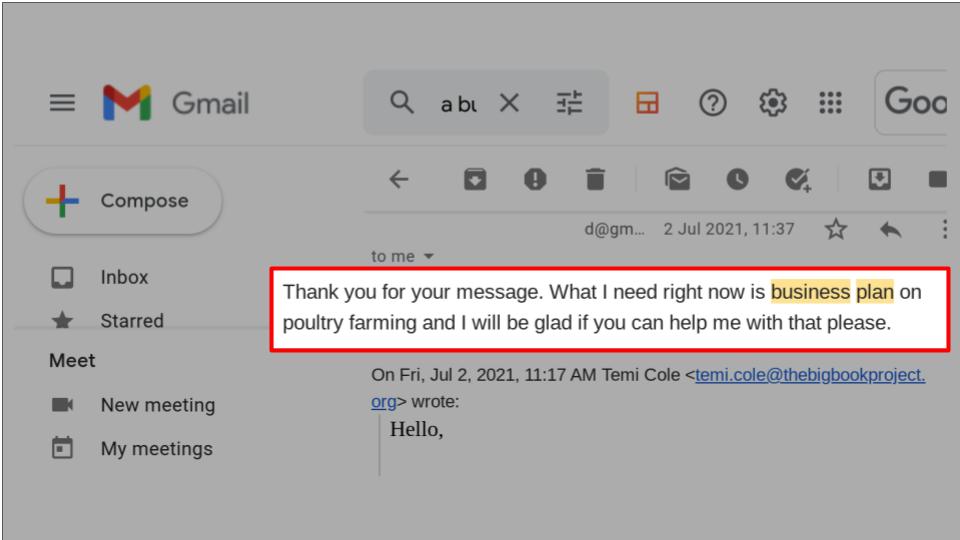
Up until now, it’s been an obvious MISS as part of The Big Book Project…
…ready-made business planning consultancy for the beginner.
I always had it in mind to plug in the gap.
It’s in me to do.
With the experience of 10+ years serving start-up entrepreneurs with strategic business planning consultancy…there are countless benefits to offer here.
However, I didn’t want to rush.
I wanted the solution I delivered to ANSWER ALL QUESTIONS. And be handed over in a way that is:
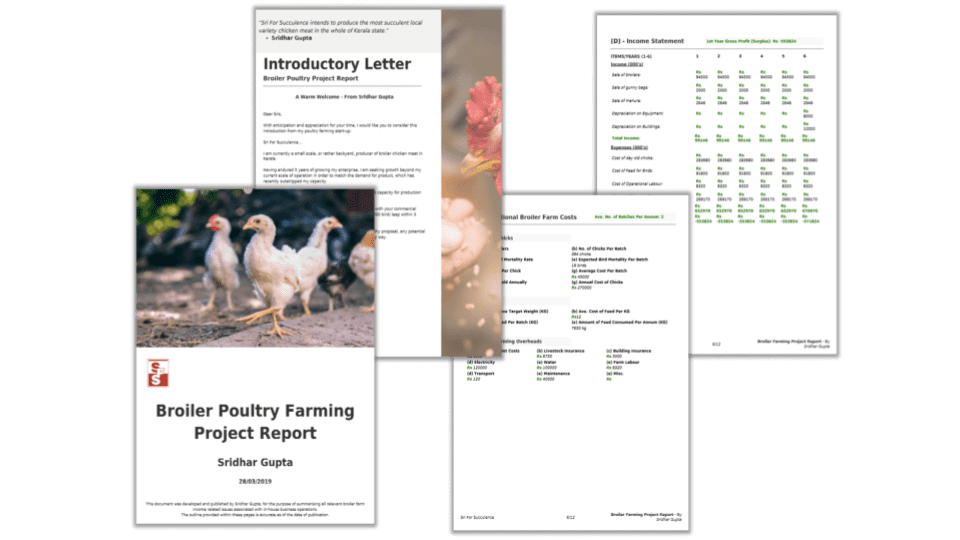
Write Your Poultry Business Plan - in Just 90 Mins!
Poultry Project Reporter 2.0 - fastest way to write your project report online.
- self-explanatory
- self-driven
…the more flexible, yet comprehensive the planning materials are – the easier they will be to use and act on.
( And business does come down to action at the last .)
The Ultimate Poultry Farming Business Planning Template
My first step was to construct what I consider to be the most complete poultry farming business plan template possible.
The kind of thing that covers both bases of:
- helping to provide clarity to your thoughts for rolling out a successful poultry business launch
- communicating an attractive proposal to potential stakeholders and investors
Pouring in over 50,000+ hours of strategic business consulting experience which spans:
- global best practice insights and technology
- corporate currency exchange
- project management
- financial advisor and stockbroker
- freelance business management advisor
…I decided upon the following outline template:
Executive Summary
What is the business?
Why is it needed?
How will it deliver?
What are the financial rewards of investment?
Industry Analysis
Industry snapshot
SWOT & PESTLE (situational) analysis
Competitive forces
Vision & Mission Statement
Key function
Aspect of life
Product type
Scope and audience
Principles & promise
Feel good and standards
Poultry farm slogan
Competitive Analysis
Products and services
Marketing and sales
Key strengths
Marketing Strategy
Physical evidence
Leadership team
Professional profile
Financial Plan
Profit and loss
Balance sheet
Labour budget
Key performance indicators (KPIs)
It’s 38-parts that together spell out every critical element of poultry business success.
You simply won’t find a more comprehensive effort to fully load a poultry farming business plan with ALL ESSENTIAL INGREDIENTS.
Want a breakdown of what each part really contains?
That’s EXACTLY what’s up next…
Step #2: Download The Poultry Farm Business Plan Analysis Playbook
As shared above, I’ve taken the time to draft what I am absolutely certain is THE market leading poultry farming business plan template – FULL STOP.
It’s got it all.
But what about the detail? And how should it be used?
Business planning analysis: the KEY to using my business plan template – like a PRO
Like so many business planning template solutions out there like bPlans, for example, they do a good job of setting a solid format, BUT…
…where they FALL SHORT is in giving you some real-life examples of how to APPLY the template .
In other words,
Most business planning tools out there don’t give you examples of how real poultry businesses measure up with the tool.
And because of this, those other planning tools leave you GUESSING what to do with it.
So you end up using it as a first-time pupil uses an exercise book:
Unskillfully and regrettably (“…don’t want to go back there again if I can help it…”).
When actually, what you NEED is a dynamic, “can’t put it down”, interactive ACTION plan – with bite.
…this is the reason I wrote this series of poultry farming business planning analyses.
Here’s what my business plan analysis will do for you…
To take all the guesswork and wandering out of planning your poultry business.
And to show you EXACTLY HOW a real-life poultry start-up success story marries up with my winning business planning formula…
…giving expert insight into how BEST to use the template to plan your own success.
The result?
(Way much better than just templates or homework…)
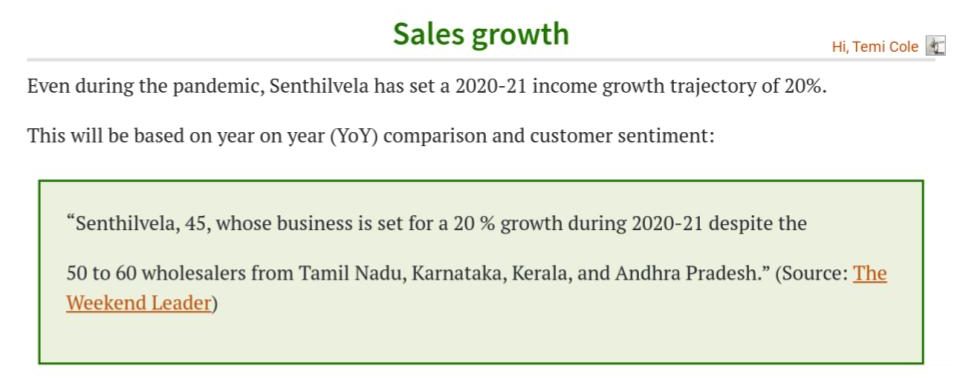
Step-by-step, proven insights of what REALLY works and why in every step of writing your own poultry business plan.
= 1st rate consultancy & on-the-shoulder advice – at your own pace ( & at only a fraction of the price ).
You can access The Poultry Farming Business Plan Analysis Playbook here (Downloadable PDF version is available to paid subscribers )
So, why is an eBook the IDEAL partner to helping your write your poultry farming business plan?
(I’m glad you asked!)
Poultry Plan It: the blueprint to winning investment for your poultry business
Rather than present you with empty template boxes to fill out (which – let’s face it – offers zero value, both to you and potential investors)…
…instead,
My eBook called, Poultry Plan It – shows you EXACTLY how to:
- skillfully deliver and
- expertly pitch
…your poultry business plan to achieve 1 thing:
To Win Investment .
(Simple. My eBook “Poultry Plan It” shows you how to get investors to take your poultry business seriously .)

Read The Poultry Business - Like Never Before!
Chicken Snippets Newsletter - deep poultry analysis to sharpen your acumen, by email.
Does this eBook sound like what you need?
Try the first chapter called “ Poultry Plan It: Executive Summary ” right here .
Want to unlock the whole eBook as PDF download?
Become a paid subscriber and get “ Poultry Plan It ” by instant PDF download .
Have you ever wanted to see:
…how the financial PROs estimate future poultry investment returns?
…which poultry production models generate the most profit?
(I mean REALLY SEE?)
Then the Poultry Project Reporter 2.0: Insider’s Guide was written just for you.
Poultry Project Reporter 2.0 – Insider’s Guide: the ‘grain-by-grain’ financial analysis EVERY poultry business plan needs
I wrote the Poultry Project Reporter 2.0 – Insider’s Guide for two pressing reasons:
- …to plug in the gap of a general lack of ‘detailed, long hand’ financial poultry business calculations available online to help with planning profits.
- …a ‘case study based’ user guide for license holders of my proprietary software ‘Poultry Project Reporter’ – to find out ALL the inside hints and tips for producing rock solid financial projections.
Here’s a quick snippet of the level of breakdown I provide:
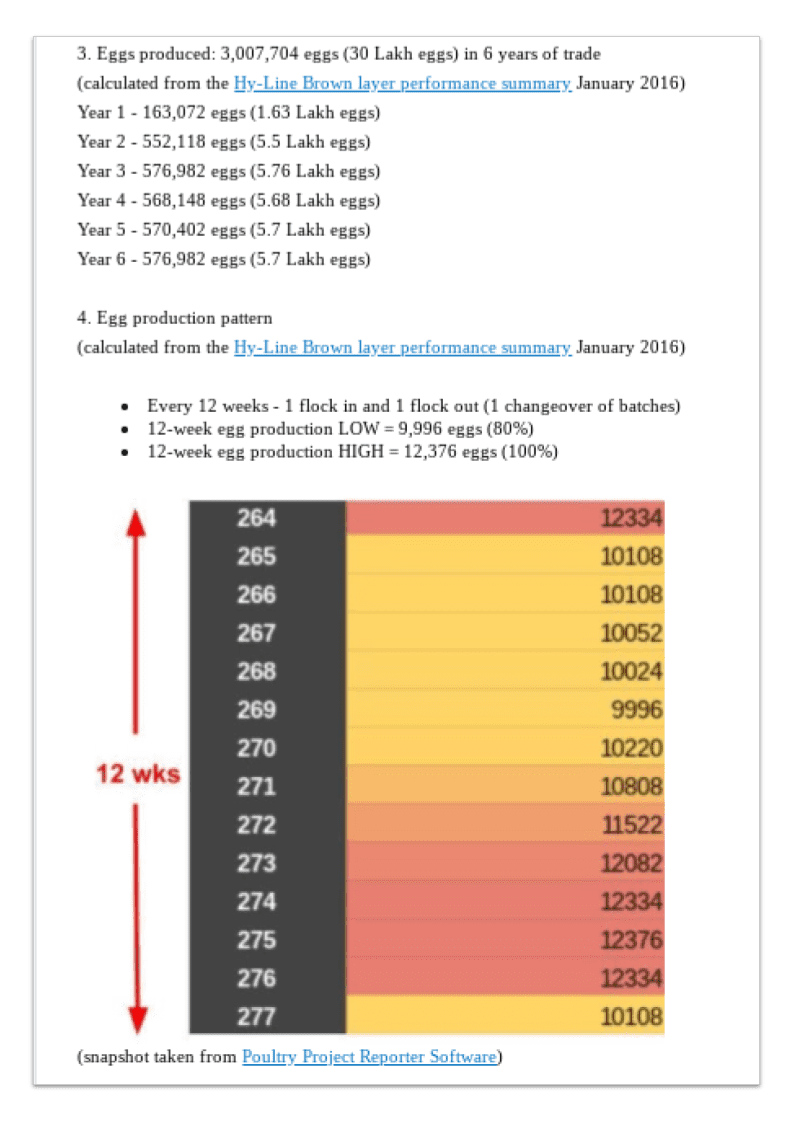
…literally, grain-by-grain, high precision detail.
BUT at the same time super simple to follow.
(With lots of visual content to really help you ‘get the picture’.)
Want to hear it from a reader?
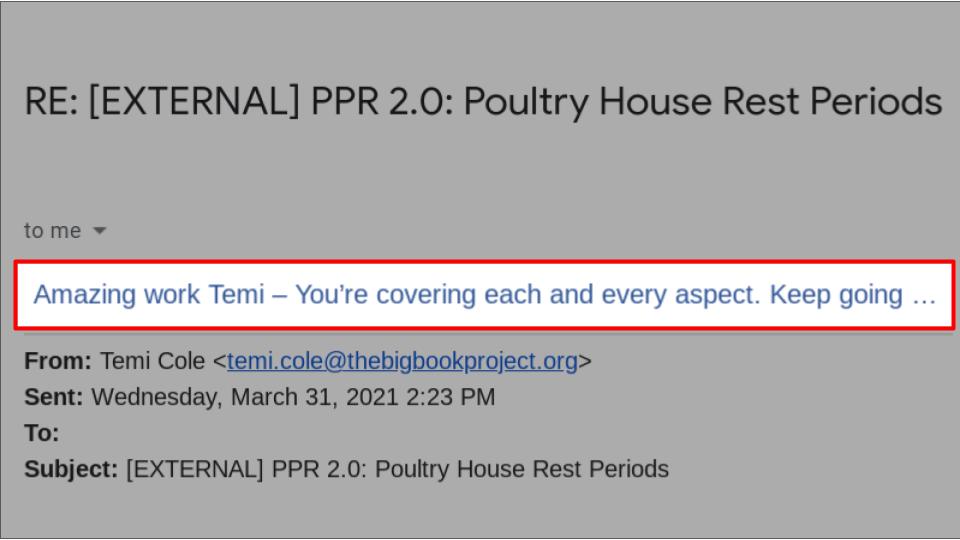
This feedback email was sent by a start-up poultry farmer.
He emailed me within minutes of receiving a mailshot of a FREE chapter from the Insider’s Guide.
So what’s actually ‘ inside ‘ the Poultry Project Reporter 2.0 – Insider’s Guide?
A great question.
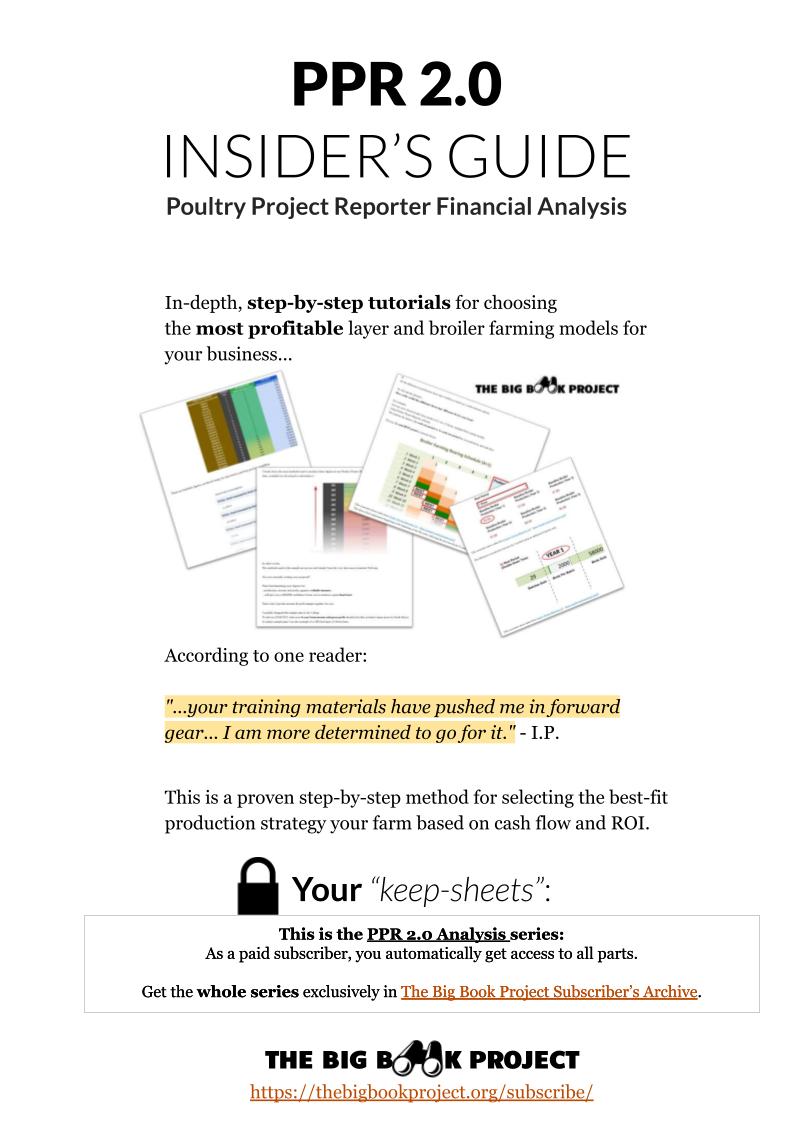
Here’s what you get:
Totally comprehensive and also a great handbook to accompany my proprietary software Poultry Project Reporter 2.0 .
Want to grab a copy of the PPR 2.0: Insider’s Guide?
Become a paid subscriber today and instantly get the inside track on financial planning for your poultry farm business.
Have a read of this:
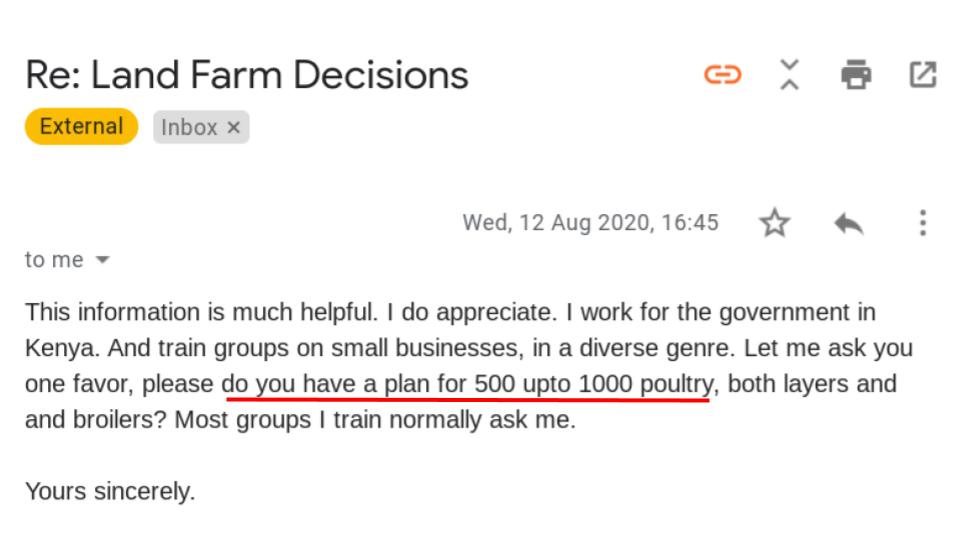
…and there are many more requests like this in my inbox.
It seems when it comes to business planning help, poultry farmers and professionals alike are interested in scanning sample data too.
( Not just templates )
Sample papers: a GREAT way for self-assessing if your business plan is up to scratch
If you ask me, examples are without doubt the BEST way to learn.
Whenever I’m looking to work out a business model I always look for working models that already exist.
Never contrived or manufactured formulas.
As an adult, I don’t like to be spoon-fed. I learn best when I’m left a little room to figure things out myself.
Let’s take it back to class…
…why are past exam papers and examiner notes such a popular revision method?
SELF-ASSESSMENT.
(i.e. finding out for yourself how you measure up against standard.)
My preferred method of advanced learning.
And I don’t think I am alone in this.
This is exactly why I put together these sample poultry farming data plans – both layer and broiler models.
I left out any country bias, so these are a universal fit to any and every economy.
What do the samples contain?
There are 2 typical planning problems that these plans are designed to solve:
- Input and output VARIABLES,
- related to the SCALE and MODEL of your farm.
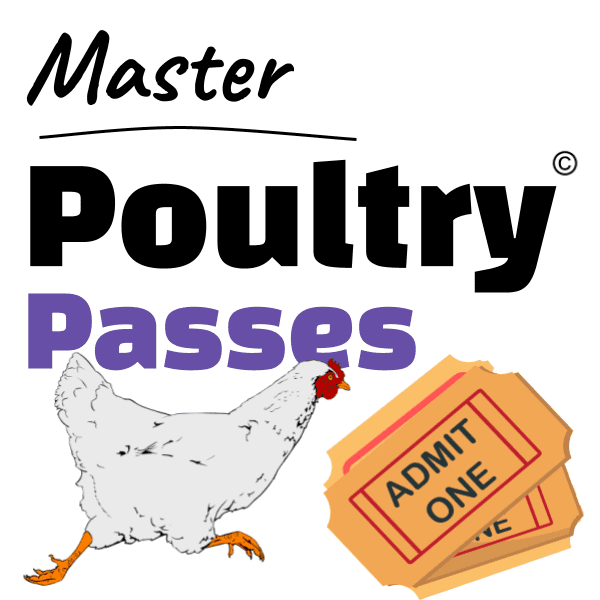
Master The Poultry Business - Like a Pro!
Poultry Courses Online - most actionable and interactive online poultry course.
In other words, these samples are shortcuts or crib notes for literally telling you if your planning progress is:
- en-route for success, or;
- taking a wrong turn .
I’ve arranged the samples according to the following attributes :
Broiler farming rearing models
- All-In-All-Out
Layer farming rearing models
Input/Output variable
- Feed consumption
- Production (meat or eggs)
- Broiler by product
These lists above are like ingredients to prescribed recipes.
Or, elements of an equation for solving a problem.
Mix them together in the right order and you answer critical questions within your poultry farm business plan.
Want an example?
The sample plans above will answer questions like,
“How much manure will a 2,000 bird broiler farm produce annually over 6 years, using the 4+1 rearing method?” Or, “How many eggs will a 5,000 layer farm produce annually over 6 years, using the 1+2 rearing method?”
Simply pull the relevant data set and immediately land your finger on the answer.
A convenient ‘plug-in’ to EVERY poultry farming business plan
Would you like a free sample?
Click on this link for a free egg production dataset for a 500-bird layer farm using 1+3 rearing system .
Now, are you ready for EVERYTHING?
Become a paid subscriber to gain instant access to ALL current sample plans PLUS future updates.
Another short falling of traditional business planning templates is that they are start-up focused .
It makes the value gained from them short-lived.
Think of it this way…
When you’ve finally launched your business, that’s just the beginning and not the end.
At the very least, you should have another 6 years on top of actually running your business.
If your templates are ONLY valid for start-up,
Then what do you use to keep your ongoing plans in order ?
Crush investment risk with my business management templates
Arguably, running the business is a far more risky phase of investment – most of all because now you have made a material commitment.
Therefore, you carry the potential of loss.
And business management also just happens to be the most challenging discipline to hold.
Because you’ve got SO MUCH going on all at the same time.
And staying organised becomes more and more difficult with every day that goes by.
CHAOS costs …
- you lose foresight, you lose track of progress and ultimately you lose money.
ORGANISATION profits …
you gain vision, you gain awareness and ultimately make money.
Business Management Templates
These templates are designed to help you stay on top.
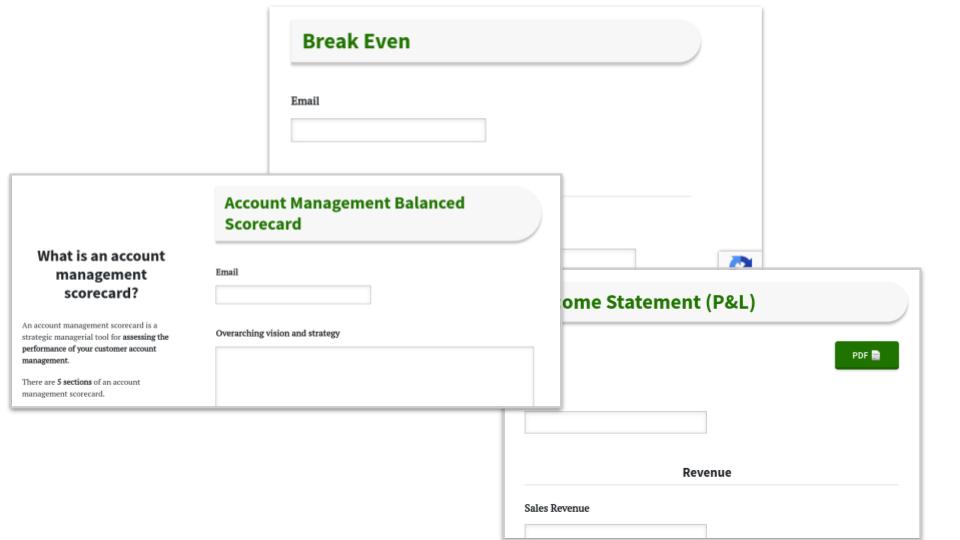
What’s included?
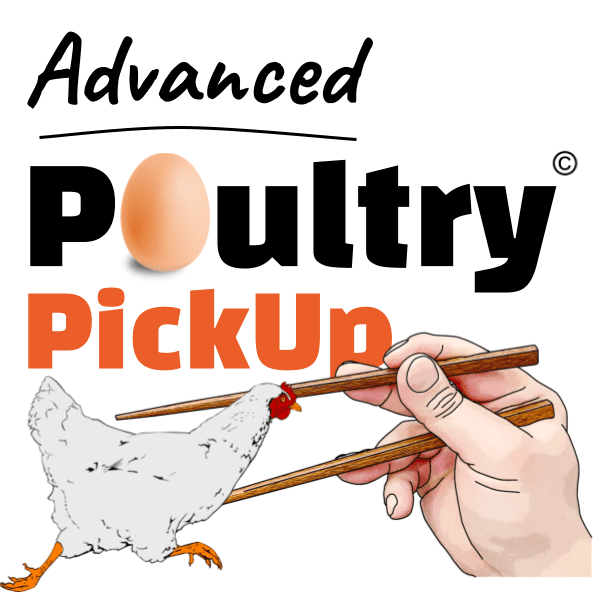
Advance Your Poultry Project - Into Maximum Profits!
Advanced Poultry Pickup - hands-on, 1-to-1 poultry business consultancy - anywhere.
Download the ‘Keep Sheet’ for future reference.
Want to start making business management plans?
Become a paid subscriber and access this suite of business management templates today.
Step #7: Download Business Records for Poultry Keepers eBook
This is a USDA eBook (United States Department of Agriculture – Farmers’ Bulletin 1614) from 1929.
(That’s right – it’s almost 100 years old!)
But testament to ‘things done well’…
…this evergreen piece of invaluable financial coaching for poultry farmers still holds true today, as when it was 1st published.
Business Records for Poultry Keepers: “Simply…DON’T attempt to write your poultry business plan without it.”
The motto of the eBook? “It literally pays for poultry farmers to keep records of current operations to guide their efforts in profitable directions.” In fact the book gives the following 6 great reasons why you need this download : (1) “… reduce the guesswork in poultry farming by helping the farmer to determine the actual reasons for poultry profits and losses,” (2) “… show the relative efficiency of different methods of production and marketing,” (3) “…make it possible for a poultry keeper to compare his results with published information (benchmark) on many poultrymen’s problems,” (4) “… show the financial progress a poultry keeper has made in his business,” (5) “… furnish information for credit statements when funds are borrowed,” (6) “… help to prevent disputes by serving as a check on business dealings.”
What is included in this eBook?
Business Records for Poultry Keepers
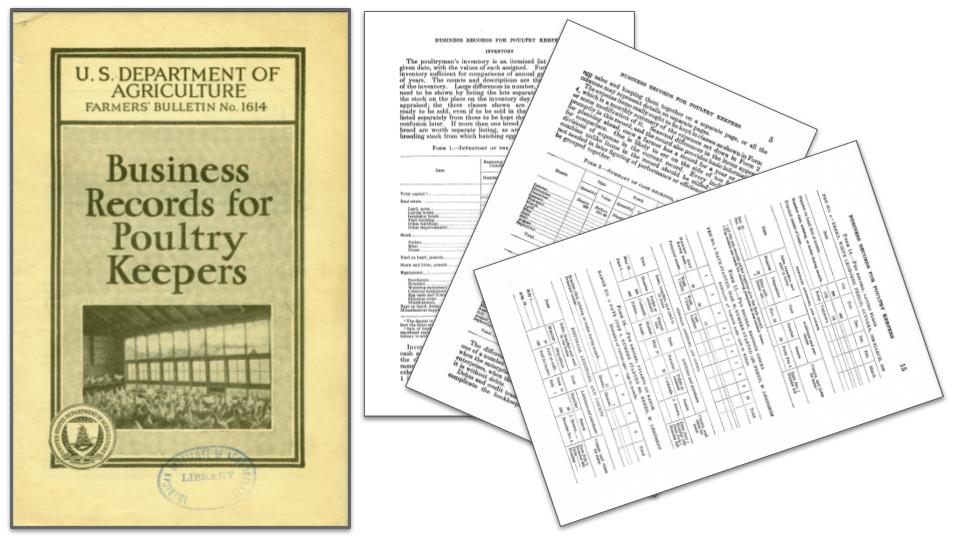
- Usefulness of poultry records
- Receipts and expenses
- Egg-production record
- Labor record
- Sales records
- Records of eggs and poultry for household use
- Pen records
- Incubation and hatching records
- Diary or notes on management
- Making use of the records
Want to pick up a copy?
Download the eBook here.
When I began writing The Big Book Project, I had one goal in mind:
To demystify investment proposal writing for start-up farmers.
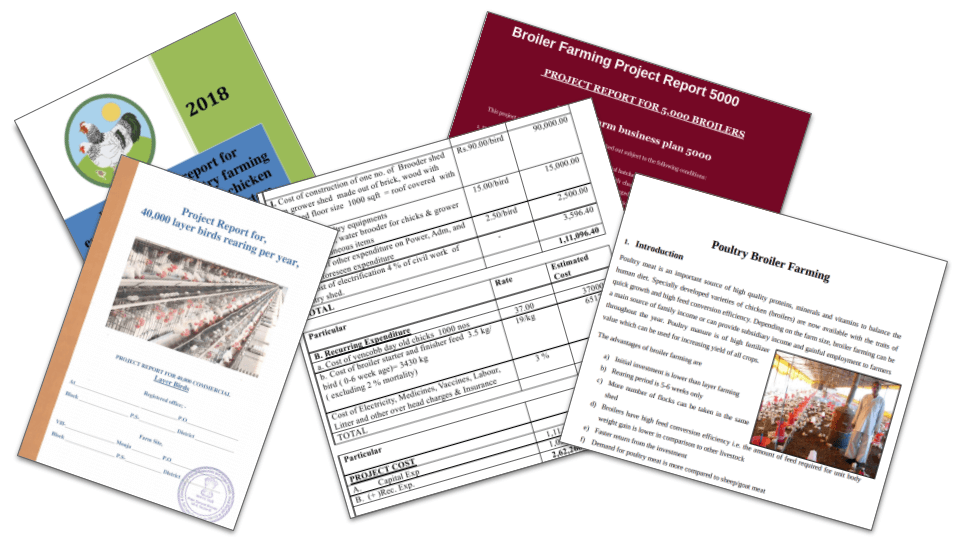
By trawling the endless blog posts and comments in the small agribiz space online,
It became clear that MANY of us have the ambition to start up.
- see borrowing as the only root
- underestimate their business plan as just a means of getting a loan
- grossly misunderstand how to model production to make a profit
…and I desperately wanted to change turn this on its head.
Only, I made up my mind that I wasn’t going to go the traditional consulting route .
- Too expensive
- VERY limited
- Anti self-sufficiency ( clients grow dependant )
So, what were the alternatives to consulting?
- Perhaps, author a book
- Develop a proprietary software
- Run online courses
…these were just a few.
Then after extensive research and thinking things through…
…I settled for all 3 of the above alternatives, wrapped up into one package:
A book, plus bespoke software and an online course.
Enter: The Big Book Project
The Big Book Project ( https://thebigbookproject.org )
- An online eBook – pushed by a blog.
- A spin-off digital business planning tool called Poultry Project Reporter.
- And an online poultry farming course called Advanced Poultry Pick-Up.
In 2 years only,
the blog amassed 170,094 new search engine visitors alone
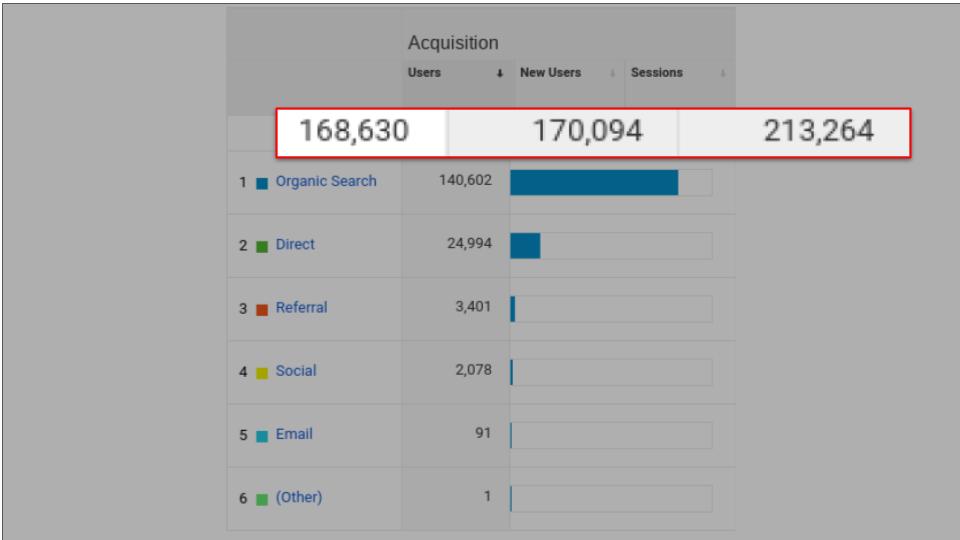
PLUS , a little over 8,000 newsletter subscribers too.
Mission accomplished.
(Well, almost – “… but what about that software? “)
Actually, one of the most popular enquiries received through my blog is for help writing poultry business proposals .
With all the best intentions in the world, there’s just not enough of me to go around the entire subscriber base giving out 1-to-1 proposal writing help.
So, I did the next best thing.
I made my advice automated (with the help of some handy digital tools) and wrote it one time only.
The result was Poultry Project Reporter and now we have just launched version 2.
What is Poultry Project Reporter 2.0?
Poultry Project Reporter 2.0: the fastest way of writing a professional poultry farming proposal
If you are looking to write a watertight poultry business proposal,
Then this Poultry Project Reporter 2.0 is a solid investment for you.
Here’s why:
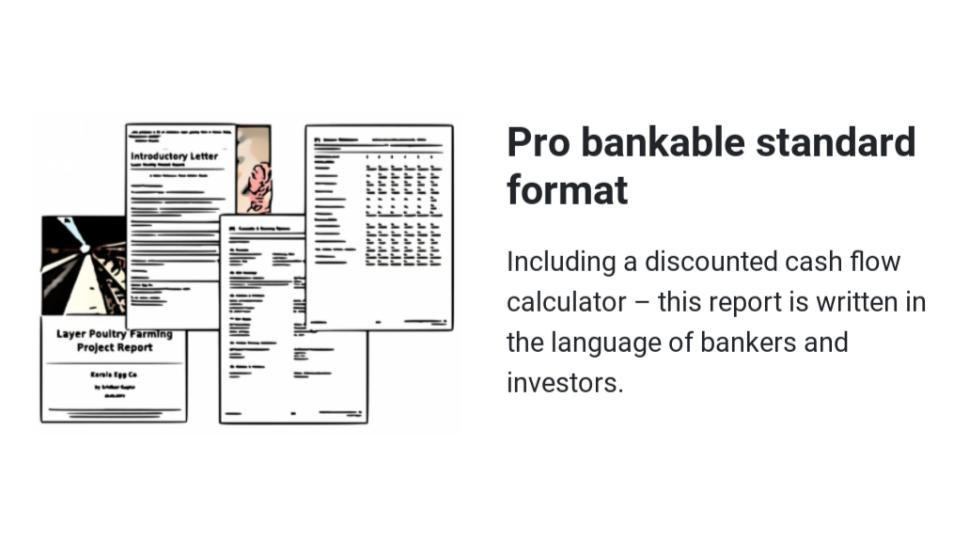
Essentially, all you have to do is type in your data into the input field and then leave the publishing (complete with PDF download) – even the calculations to PPR 2.0
Are you ready to take a closer look at Poultry Project Reporter? Take a look at the dedicated Poultry Project Reporter 2.0 website
Poultry farming as a topic is MASSIVE worldwide.
It seems, when it comes to the subject matter of poultry farming, every country is both ‘ stalking it ‘ and ‘ talking it ‘ online.
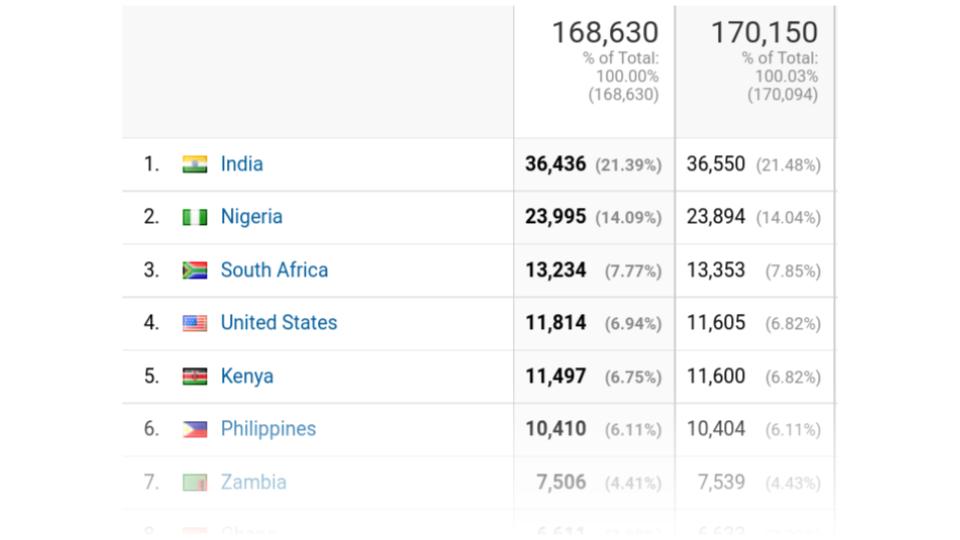
These stats from my blog above tell the tale of poultry farming and its popularity. It literally reaches every country in the world .
And despite all this talk about poultry farming business plans…
…I find a large percentage of the ‘audience’ has no capital funding availability (whether saved or borrowed) . Of course, this is totally natural and a reality for the majority, AND if you ask me a great ADVANTAGE.
Take this reader of my blog:
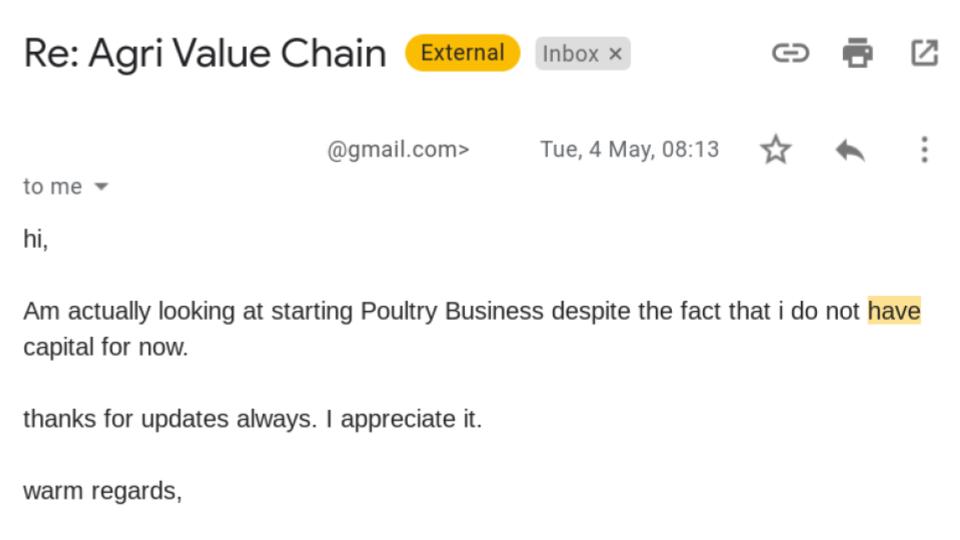
It seems many see a lack of capital as a barrier to entry when it comes to layer or broiler farming.
“But who said anything about needing significant capital to start up a profitable poultry business ?”
One of the BIGGEST attractions to poultry farming surely is the LOW BARRIER to entry , LOW SETUP costs and yet HIGH profitability and cash flow potential.
But as with many theories, I suppose it remains ‘up in the air (talked about)’ until someone makes it tangible…material…possible.
This is the principle that encouraged me to step up to the plate in an attempt to ‘bat out of the park’ all doubt surrounding it…
…and finally, answer the question:
Can you start up a poultry farm with zero capital?
Yes, you can start a poultry farm with no available capital.
Here’s how…
Zero Debt Poultry Farming: the MOST REWARDING way to start, scale and establish a leading egg or chicken business
In my line of work as a consultant (professional problem solver) – the one discipline that keeps my craft alive is RESEARCH.
And as such, I come across all kinds of neat fixes that may not be for the time I find them,
But are bound to come in handy some time.
So, much like a handyman or craftsman, not wanting to let anything go that could be of use,
I end up keeping a stash of these in a ‘kind of’ strategic toolbox.
When enough time passes by whilst researching related topics,
I get enough of a head of steam to begin compiling an eBook.
This is my process.
And using this I wrote ‘ Zero Debt Poultry: Business Startup Plan ‘.
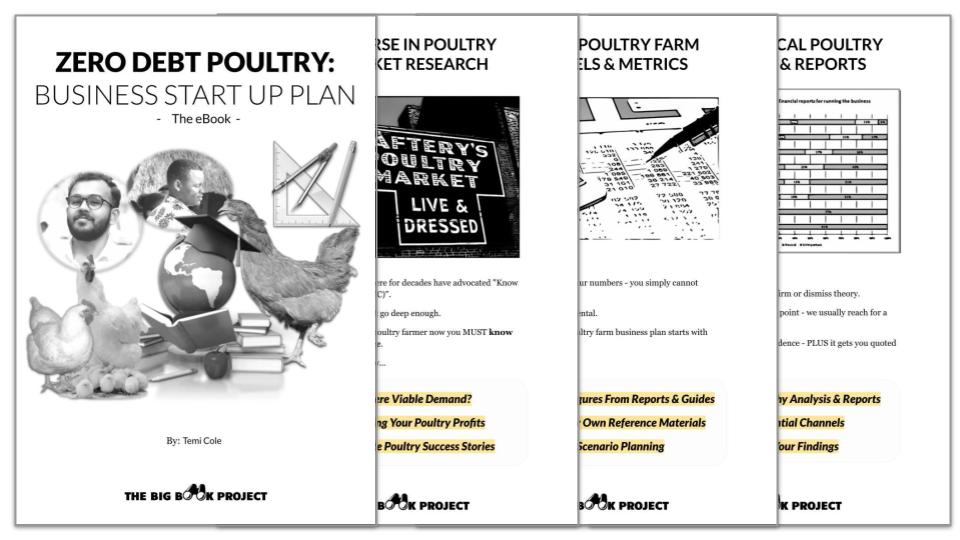
It’s a strategic playbook and secret formula for how (with no borrowings or savings) you:
- turn your poultry startup idea into a market-leading farming enterprise
- BEFORE you yield your 1st egg or carcass .
Want the PDF download?
Become a paid subscriber today and download Zero Debt Poultry Business Startup Plan .
I had to refrain from using the phrase, “Masterclasses”…a bit presumptuous for my liking.
Aren’t we always needing to ‘add on’ – even after many years of experience? Are ever really the finished article?
Whatever your answer to those questions is,
I do think what is indisputable is the benefit of someone else’s EXPERIENCE when you don’t have any…
… experience saves loss …
…loss of:
…and in the case of business startup, the benefit of experience in some critical areas can be the difference between success and failure.
And where so much is riding on you making it work,
Getting the right experience is HIGHLY valued.
Equally, identifying the most advantageous area of learning carries importance.
So, what area of learning would you say has the most impact on farming success?
According to this study , ‘ Farm Business Management Skills a Missing Link For Smallholder Farmers: A Case Of Malingunde, Malawi ‘ (European Journal of Business and Innovation Research 2016): Just one of many studies which declare a link between business management discipline and better economic output . Other quotes from the study bear reference to previous works: “Generally, management is a human responsibility and skill that drives economic activities and development ( Oghojafor et al, 2012 ).” “Smallholder farmers need to be better equipped with business management skills if they are to play a central role in improving agricultural productivity ( Mohit, 2012 ).”
So, there you have it – business management is the most influential skill set you could acquire for succeeding with your poultry startup.
But is there really a shortage of business management material on the internet?
Not according to Google,
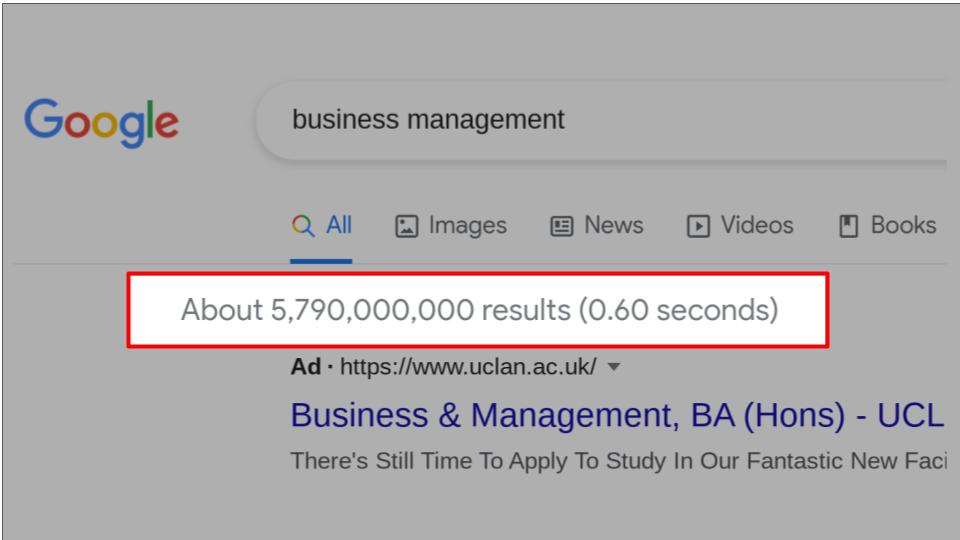
As you can see above, it took Google 0.6 seconds to return almost 6 BILLION results for the search term ‘business management’.
That’s a FLOOD of management content.
But…I ask:
- Is all of it good ? Or at least suitable for a startup poultry farmer?
- Also, where do you begin ?
To save you ENDLESS wandering from page to page online,
I have neatly packaged a power-packed portfolio of business management tutorials tailor-made for EVERY startup farmer…
…called “Grow AgriBusiness Faster Classes”
Grow AgriBusiness Faster Classes: instantly download 15 years of 1st class management expertise ( & speed up your poultry profits )
The purpose of these tutorials is to make common with you some of the most valuable business management lessons learned in my 15 years of management.
They span a corporate and independent consulting career, including:
- global best practice
- financial investments
- small business strategy
But the goal is simple…
…to make hard things simple for you to ‘master’ (…there, I’ve said it now…) to save you any potential material losses of getting it wrong.
These lessons should help you to get it right, 1st time.
The GREAT thing about these tutorials also is that they are all written from 1st hand experiences and lessons learned . Nothing academic – all true to life .
Here’s currently what is included :
Want to access the Grow AgriBusiness Faster Classes?
Become a paid subscriber today and fast forward your management abilities.
Are you currently working on a feasibility plan & business proposal for your future poultry farm?
Then this resource is the ideal pocketbook and project reference guide for equipping you with EVERYTHING you need to draft a winning plan.
It’s called the Poultry Project Hub…

Poultry Project Hub: a jampacked project resource library giving you 100’s of angles on planning optimal profits
This has to be the most plentiful online digital resource for assisting your poultry business proposal writing .
Here’s a quick round-up of its contents:

In short, the Poultry Farming Project Hub contains:
“…over 20,501 words, 200+ rows of data tables, as well as 30+ screenshots/images, sample calculations, case studies and more.”
If you are looking for:
- sample plans
- expert poultry business consultancy
- step-by-step calculations
- definitions and equations for investment metrics
- case studies
- detailed ‘explainer’ articles on hard to understand model concepts
…then this is an unmissable opportunity for you.
Visit the library and its FREE resources now.
Want to download the entire library in PDF instead?
Become a paid subscriber and get the PDFs.
This is very simply – a little bit of light relief if you are finding the whole exercise of business planning a little…frustrating.
There are 15 questions in this quiz.
Each covering a key poultry farming discipline.
It’s multiple choice and nothing too heavy.
Ideally, you might use them to sharpen up your general strategic business awareness.
Try the poultry business quiz.
I made this as a complementary guide to be read alongside sample poultry plans.
To help you better DIRECT the planning process.
To have you asking the right questions and taking the right approaches to assemble your poultry business plan successfully.
Plus, I provide insight into:
- production modelling options and,
- uncover flawed assumptions.
These points above are often sticking points and wrong turns for many when building a plan.
This eBook helps you avoid the loss of time and effort getting tied up in with grey spots.
And here’s how…
Poultry Planning Toolkit eBook: avoid common planning errors by having this on your desk as you work
I’d go as far as saying that you shouldn’t begin writing your poultry farm business plan UNTIL you’ve read this.
It does the job of ironing out all the usual sticking points that trouble and prolong planning.
Issues such as:
- modelling choices
- how best to plan your earnings
- how to measure profitability
- how to do capital planning
…are opened up with ease and made plain.
Here’s the chapter line-up :
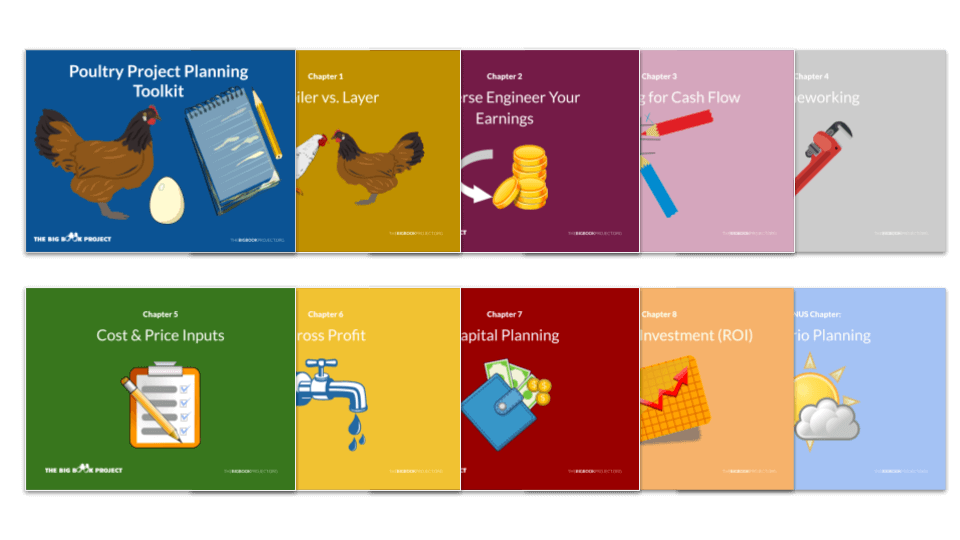
- Broiler vs. Layer
- Reverse Engineer your Earnings
- Modelling for Cash Flow
- Frameworking
- Cost & Price Inputs
- Gross Profits
- Capital Planning
- Return on Investment
- Scenario Planning
I designed it to answer ALL the key strategic planning questions.
I’d say, the real value of this eBook is that it prevents false starts by filling in the common knowledge gaps .
A great time saver.
Take a few minutes to read a chapter for free .
Want to download the entire PDF eBook?
Become a paid subscriber today and get expert direction for writing a successful poultry business plan.
This one is quite simple.
If it’s ever cross your mind to ask,
“Hey Temi, what website software do you use?”
“What service do you use to send out those email messages?”
For example, I use WPMUDEV as my web hosting partner. They are just right for The Big Book Project currently. It’s true that there are many cheaper web hosting services out there, But the operative word here is * SERVICE* . When I fail, they pick up the pieces and always ensure The Big Book Project is constantly online. No downtime, no curveballs, no disasters…you see everything coming LONG before it hits, giving plenty of time to react successfully…PLUS, when trouble hits, they REALLY know how to rescue a WordPress website . Hands down. I have no complaints and many good things to say…if you are looking for an expert WordPress website support team – I couldn’t recommend them highly enough . Learn more about WPMUDEV here. (The link above goes to their website and of course costs you nothing. If you decide to hire them, I get a small payment back. The money side has no influence though. I personally use them and happily recommend their service.)
My other tools of the trade including:
- graphic design tool
- online payment gateway
- document management tools
- email marketing platform
- accounting program (inc. invoicing, quotations etc).
…are all neatly listed in the crib sheet.
It’s exhaustive. And comes with 10 years of self-employment and business ownership experience.
Lots of valuable, ‘hard-to-find’ gems to give you plenty of advantage.
(*Plus there are some GREAT time and budget savers in here to help you save the pennies, without compromising on quality.)
Want to download my Digital Tools of The Trade crib sheet?
Become a paid subscriber today and get a headstart on digital business services.
Whilst I don’t write business plans, I do review them from time to time.
From your point of view, it might be a useful pointer in the right direction.
Just the thing you need to get you out of a rut and to finally complete your plan.
A bit like this:
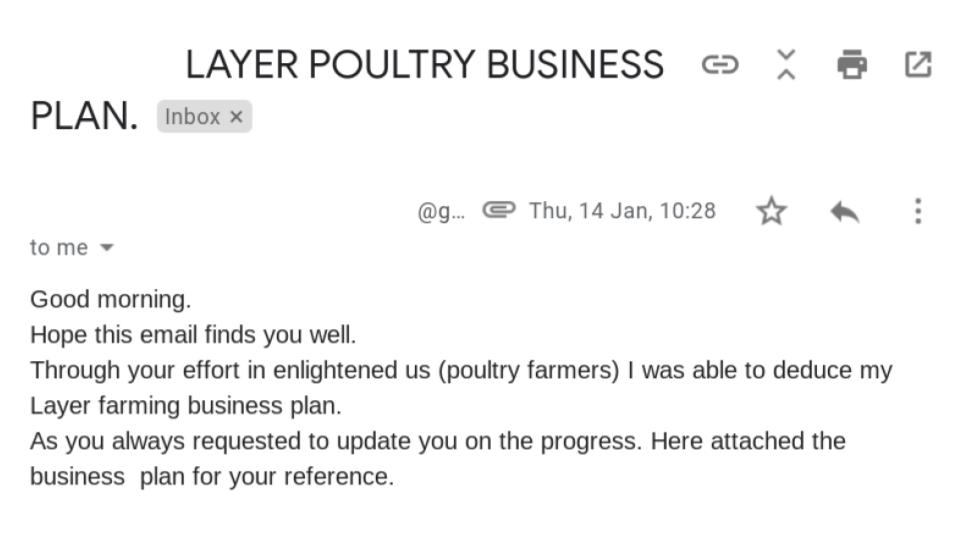
…always good to see REAL LIFE RESULTS gained by readers of The Big Book Project who put the advice into action .
Want me to take a look at your poultry farm business plan?
Become a paid subscriber today and book your business plan review.
Now over to you…
Are you currently writing a business plan for your poultry farm?
Have you already drafted your plan?
Either way, I’d be interested to hear from you.
Leave a comment below.
Reader Interactions
Write your poultry project proposal in just 90 mins.
February 22, 2024 at 1:44 pm
My first time to visit this web site. I am impressed and subscribed soon. Hope I will be benefited from the package. Inspired by quick response of the system and tells how efficient and profitable the poultry business too. I will keep myself long in the transaction. Regards, Assefa T.
Leave a Reply Cancel reply
Your email address will not be published. Required fields are marked *
Join 15,000 Subscribers…
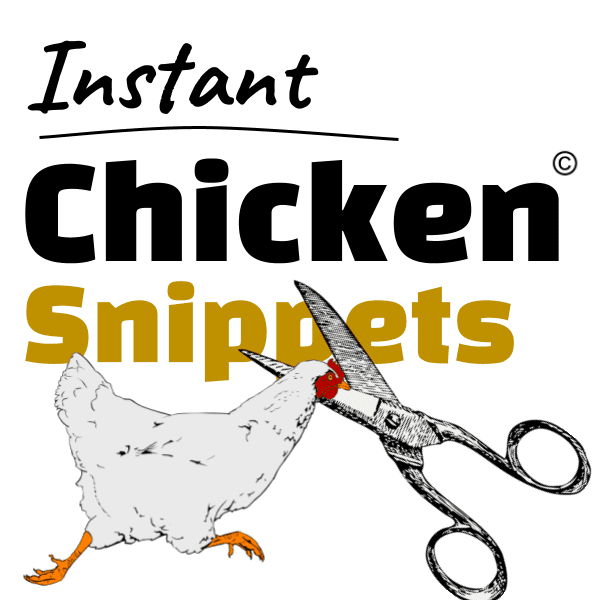
Get The #1 Poultry Farming Newsletter
The most in-depth guide to poultry farming anywhere , right now.
– Kwasi Jones
Receive all the ‘insider tips’ they never speak about to help you:
- ✔️ Write a plan that actually gets investment
- ✔️ Decide if poultry will be profitable for you
- ✔️ Avoid pitfalls like mortality with key procedures
- ✔️ Understand the hidden benefits of production models
Type in your email below…
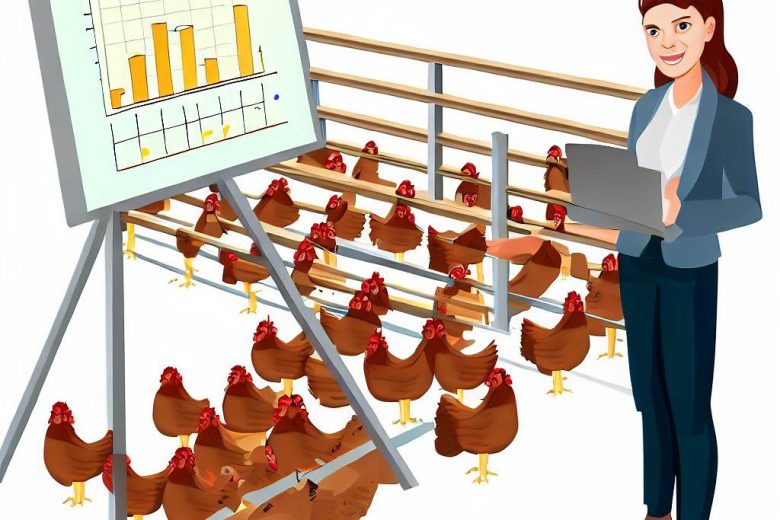
[Pdf Sample] Broiler Farm Business Plan Proposal Docx
Starting a broiler chicken business can be a profitable venture for individuals interested in the poultry industry. Raising 1000 broiler chickens requires careful planning and execution to ensure success. This article will guide you through the essential steps of creating a business plan for a broiler chicken operation.
[Pdf Sample] Business Plan For 1000 Broiler Chickens Docx
Table of Contents
Read Also: [Pdf Sample] Business Plan For Goat Farming Business Docx
Executive Summary
Market analysis.
Read Also: [Pdf Sample] Business Plan For Poultry And Fish Farming Docx
Business Structure and Location
Infrastructure and equipment.
Read Also: [Pdf Sample] Business Plan For Tilapia Fish Farming Docx
Procuring Broiler Chicks
Feed and nutrition.
Read Also: [Pdf Sample] Business Plan For Fish Farming Docx
Health and Biosecurity
Sales and marketing strategy.
Read Also: [Pdf Sample] Business Plan For Sunflower Farming Docx
Financial Projections
Risk management.
Here Is The Download Link For Business Plan For 1000 broiler chickens Farm Proposal By Agrolearner.com
Business Model Canvas: Agrolearner.com – 1000 Broiler Chickens Business
Key partners:.
Veterinarians: Provide healthcare services and advice on disease prevention and treatment.
Key Activities:
Broiler Chicken Production: Raising and nurturing broiler chickens from day-old chicks to market-ready size.
Marketing and Sales: Promoting and selling broiler chickens to local retailers, restaurants, and individual consumers.
Key Resources:
Land: Sufficient land area for housing broiler chicken houses and infrastructure.
Knowledge and Expertise: Industry knowledge, understanding of broiler chicken farming best practices , and business management skills.
Value Proposition:
Nutrition and Health Benefits: Offering broiler chickens raised on a balanced and nutritious feed program, appealing to health-conscious consumers.
Customer Segments:
Local Retailers: Supermarkets, butchers, and poultry shops seeking a reliable supplier of high-quality broiler chickens.
Direct Sales: Establishing direct relationships with local retailers, restaurants, and hotels to supply broiler chickens.
Customer Relationships:
Personal Relationships: Building strong relationships with customers based on trust, reliability, and responsiveness.
Revenue Streams:
Broiler Chicken Sales: Revenue generated from the sale of broiler chickens to local retailers, restaurants, and individual consumers.
Cost Structure:
Feed and Inputs: Cost of high-quality feed ingredients, vaccines, medications, and other inputs required for broiler chicken production.
Overhead Expenses: Utilities, insurance, administrative costs, and maintenance expenses.
Key Metrics:
Feed Conversion Ratio: Efficiency of feed utilization measured by the amount of feed consumed per unit of weight gained.
By adopting this business model, Agrolearner.com aims to establish a profitable and sustainable broiler chicken farming operation, meeting the demand for high-quality broiler chickens while prioritizing nutrition, health, and customer satisfaction.
How much space do I need for 1000 broiler chickens?
What is the typical growth period for broiler chickens, how many feedings per day are required for broiler chickens.
Initially, broiler chickens require frequent feedings, usually 4 to 5 times a day. As they grow, the feeding frequency can be reduced.
What are the common diseases affecting broiler chickens?
How can i ensure the quality of broiler chicken meat.
In conclusion, Agrolearner.com is well-positioned to capitalize on the growing demand for high-quality broiler chickens in the local market. Our comprehensive business plan , supported by detailed market analysis, strategic infrastructure, and effective sales and marketing strategies, provides a solid foundation for success.
Share this:
Author: adewebs, you may also like:, how to grow successfully tomatoes in a greenhouse, [pdf sample] business plan for pig farming docx, starting a poultry farm with limited resources in ghana: a comprehensive guide for new farmers, how to register agribusiness company in kenya (see full guide), leave a reply cancel reply.

Broiler Farming Business Plan [Sample Template]
By: Author Tony Martins Ajaero
Home » Business ideas » Agriculture Industry » Livestock Farming » Poultry » Poultry Business Plan

Are you about starting a broiler farm? If YES, here’s a complete sample broiler farming business plan template & feasibility report you can use for FREE to raise money .
There are loads of business opportunities in the poultry industry and broiler farming is one of them. Broilers are chickens that are specifically raised for meat. These chickens are typically white and are farmed to produce meat for consumers.
Suggested for You
- Poultry Farming Business Plan [Sample Template]
- Free Range Chicken Farm Business Plan [Sample Template]
- Layer Farming Business Plan [Sample Template]
- Oyster Farming Business Plan [Sample Template]
- Indoor Shrimp Farming Business Plan [Sample Template]
Why Start a Broiler Farm?
Broiler farming is known to be a profitable business and has evolved from small scale to a global industry in most countries where it is carried out.
Countries like Nigeria , United Kingdom, Brazil, Greece, Philippines, China, Japan, Thailand, Caribbean countries and even South American Countries have been farming broilers on a large scale for a long while. united states is not far from the trade as there are a lot of people who are making huge fortune from farming broilers alone.
If you are looking to go into the poultry farming business, the good news is that you can’t get it wrong with the broiler farming business. It is easy to start, cheap to maintain and it takes a short time to get a good return on your investment if you know the ropes.
Starting a broiler farming business comes with its own fair share of challenges, but that does not rule out the fact that it is indeed a profitable business venture. An aspiring entrepreneur can either choose to start a broiler farm on a small scale or on a large scale depending on their financial status.
So, if you have decided to go into broiler farming, then you should ensure that you carry out thorough feasibility studies and also market survey. This will enable you to properly locate the business in a good location and then hit the ground running.
Business plan is yet another very important business document that you should not take for granted when launching your own business. Below is a sample broiler farming business plan template that can help you to successfully write your own with little or no difficulty.
A Sample Broiler Farming Business Plan Template
1. industry overview.
The chicken and turkey meat production industry that broiler farming is a subset of is indeed a large and profitable industry. Most often than not, broiler chickens are raised in large, open structures called houses, where they are allowed to freely roam, explore, eat and commune with other chickens.
Some (including free-range chickens) have varying access to the outdoors, based on the farmer preference and of course their safety. The Chicken and Turkey Meat Production industry includes poultry farms that raise turkeys and chickens basically for meat production.
Downstream meat processors and food producers supply farmers with turkeys, chicks, feed and payment, according to contractual agreements. Poultry farmers provide growing facilities, bird care and agricultural expertise. Revenue is recorded in the final prices that poultry farmers receive per average weight of live turkey or chicken.
The Chicken and Turkey Meat Production industry in recent time has experienced positive trends in demand for turkey and chicken meat. Of course, increasing health consciousness among American meat consumers has boosted consumption of white meat such as turkey and chicken, which is also more affordable than beef or pork.
Going forward, the industry will continue to enjoy appreciable growth and turkey and chicken farmers will keep smiling to the bank. Falling input prices will enable turkey and chicken farmers to increase production volumes; on the other hand, many farms will consolidate to gain the benefits of economies of scale.
In the United States of America, most poultry farmers have been functioning for more than ten years. They are often family enterprises passed down from one generation to another. The major barriers facing new entrants into the industry include the competitive nature of a contract based income system, the medium level of investment required and of course compliance with various environmental regulations.
The Chicken and Turkey Meat Production industry is indeed a very large industry and pretty much thriving in all parts of the world. Statistics has it that in the United States of America alone, there are about 38,065 licensed and registered chicken and turkey meat production companies directly responsible for employing about 56,306 employees.
The industry rakes in a whooping sum of $34 billion annually with an annual growth rate projected at 2.7 percent. It is important to state that there are no establishments with a lion share in this industry; every turkey and chicken farm can compete favorably.
Statistics also has it that an estimate of about 35 companies are involved in the business of raising, processing and marketing chickens on a commercial level; they export live chickens, processed chickens and eggs to other countries of the world.
It is on record that Americans consume more chicken than anyone else in the world – more than 90 pounds per capita in 2015 – the number one protein consumed in the United States. So also, in 2015, almost 9 billion broiler chickens weighing 53 billion pounds, live – weight, were produced. More than 40 billion pounds of chicken products were marketed, measured on a ready-to-cook basis.
The United States has the largest broiler chicken industry in the world, and about 19 percent of egg and chicken produced were exported to other countries in 2015. Research conducted shows that the top 5 broiler producing states in the US are Georgia, Arkansas, Alabama, North Carolina and Mississippi.
If you are looking towards leveraging on the agriculture industry to generate huge income, then one of your best bet is to start a broiler farming business.
One thing is certain about starting a broiler farming business, if you are able to conduct your market research and feasibility studies, you are more likely not going to struggle to sell your broiler cum chicken meat because there are always food processing companies and consumers out there who are ready to buy from you.
2. Executive Summary
Teddy Bright® Poultry Farms, LLC is a world – class poultry farm company with strong bias for rearing broilers. Our poultry farm will be based in the outskirt of Santa Fe, New Mexico – United States. We have done our detailed market research and feasibility studies and we were able to secure hundred hectares of land to start our poultry/broiler farm and chicken meat production business.
Our broiler farm is going to be a standard commercial poultry farm and will be involved in raising, processing and marketing broiler – chicken meat on a commercial level; we will export live broiler – chickens, and processed and packaged chicken meat to other countries of the world.
We are in the commercial broiler farming and chicken meat production line of business because we want to leverage on the vast opportunities available in the agriculture industry, to contribute our quota in growing the U.S. economy, in national food production, and also to export live broiler – chicken and processed and packaged chicken from the United States to other countries of the world.
Teddy Bright® Poultry Farms, LLC is well positioned to become one of the leading commercial broiler- chicken farms in the United States of America, which is why we have been able to source for the best hands and machines to run the company with.
We have put process and strategies in place that will help us employ best practices when it comes to commercial poultry farming, chicken meat processing and packaging as required by the regulating bodies in the United States of America.
At Teddy Bright® Poultry Farms, LLC, our customer’s best interest will always come first, and everything we do will be guided by our values and professional ethics. We will ensure that we hold ourselves accountable to the highest standards by meeting our client’s needs precisely and completely. We will cultivate a working environment that provides a human, sustainable approach to earning a living.
Teddy Bright® Poultry Farms, LLC is a privately registered commercial poultry farm and chicken meat processing and packaging company that is owned by Mr. Teddy Bright and his immediate family members. The poultry farm will be fully financed by the owner – Mr. Teddy Bright and his immediate family members at least for a period of time.
Before starting Teddy Bright® Poultry Farms, LLC, Mr. Teddy Bright gathered robust experience working for some of the top brands in the poultry farms industry in the United States of America. He is of course well experienced and highly qualified to run this type of business.
3. Our Products and Services
Teddy Bright® Poultry Farms, LLC is a standard commercial poultry farms and broiler – chicken meat processing and packaging company that is committed to raising chickens (broiler) for both the United States’ market and the global market.
We are in the commercial poultry farms and chicken meat production line of business to make profits and we are going to do all we can to achieve our business goals, aim and objectives. These are the areas we will concentrate on in our commercial poultry farms. If need arises we will definitely add more poultry produce to our list;
- Raising, processing and marketing broilers (chickens) on a commercial level; we export live chickens (broilers), and processed and well packaged chicken meat to other countries of the world.
4. Our Mission and Vision Statement
- Our Vision is to become one of the leading commercial poultry farm and chicken meat production brands not just in the United States of America but also on the global stage.
- Teddy Bright® Poultry Farms, LLC is a world class and registered commercial poultry farms and chicken meat production company that is committed to raising broiler-chickens and producing chicken meat for both the United States’ market and the global market.
- We want our live broiler-chickens and well processed and packaged chicken meat to flood the nooks and crannies of the United States and other countries of the world.
Our Business Structure
Teddy Bright® Poultry Farms, LLC is a privately owned and managed commercial poultry farm and chicken meat production business that intend starting small in Santa Fe – New Mexico, but hope to grow big in order to compete favorably with leading commercial poultry farms and egg production companies in the industry both in the United States and on a global stage.
We are aware of the importance of building a solid business structure that can support the picture of the kind of world class business we want to own. This is why we are committed to only hire the best hands within our area of operations.
At Teddy Bright® Poultry Farms, LLC, we will ensure that we hire people that are qualified, hardworking, and creative, result driven, customer centric and are ready to work to help us build a prosperous business that will benefit all stakeholders (the owners, workforce, and customers).
As a matter of fact, profit-sharing arrangement will be made available to all our senior management staff and it will be based on their performance for a period of five years or more as agreed by the board of trustees of the company. In view of the above, we have decided to hire qualified and competent hands to occupy the following positions;
- Chief Operating Officer
General Poultry Farm Manager
Human Resources and Admin Manager
- Accountant / Cashier
- Sales and Marketing Executive
- Field Employees
- Front Desk Officer
5. Job Roles and Responsibilities
Chief Executive Officer – CEO:
- Increases management’s effectiveness by recruiting, selecting, orienting, training, coaching, counseling, and disciplining managers; communicating values, strategies, and objectives; assigning accountabilities; planning, monitoring, and appraising job results; developing incentives; developing a climate for offering information and opinions; providing educational opportunities
- Creating, communicating, and implementing the organization’s vision, mission, and overall direction – i.e. leading the development and implementation of the overall organization’s strategy
- Responsible for fixing prices and signing business deals
- Responsible for providing direction for the business
- Responsible for signing checks and documents on behalf of the company
- Evaluates the success of the organization.
- Responsible for the planning, management and coordinating all farm activities across the various sections on behalf of the organization
- Supervises other section managers
- Ensures compliance during project executions
- Providing advice on the management of farming activities across all section
- Responsible for carrying out risk assessment
- Using IT systems and software to keep track of people and progress of the growth of chickens and other birds
- Responsible for overseeing the accounting, costing and sale of poultry farm produce
- Represent the organization’s interest at various stakeholders’ meetings
- Ensures that broiler farming goals desired result are achieved, the most efficient resources (manpower, equipment, tools and chemicals et al) are utilized and different interests involved are satisfied. Responsible for preparing financial reports, budgets, and financial statements for the organization
- Responsible for overseeing the smooth running of HR and administrative tasks for the organization
- Updates job knowledge by participating in educational opportunities; reading professional publications; maintaining personal networks; participating in professional organizations.
- Enhances department and organization reputation by accepting ownership for accomplishing new and different requests; exploring opportunities to add value to job accomplishments.
- Defining job positions for recruitment and managing interviewing process
- Carrying out staff induction for new team members
- Responsible for training, evaluation and assessment of employees
- Oversee the smooth running of the daily office
Accountant/Cashier:
- Responsible for preparing financial reports, budgets, and financial statements for the organization
- Provides management with financial analyses, development budgets, and accounting reports; analyzes financial feasibility for the most complex proposed projects; conducts market research to forecast trends and business conditions.
- Responsible for financial forecasting and risks analysis
- Performs cash management, general ledger accounting, and financial reporting for one or more properties
- Responsible for developing and managing financial systems and policies
- Responsible for administering payrolls
- Ensuring compliance with taxation legislation
- Handles all financial transactions for Teddy Bright® Poultry Farms, LLC
- Serves as internal auditor for Teddy Bright® Poultry Farms, LLC.
Sales and Marketing Manager
- Manage external research and coordinate all the internal sources of information to retain the organizations’ best customers and attract new ones
- Model demographic information and analyze the volumes of transactional data generated by customer
- Identifies development opportunities; follows up on development leads and contacts; participates in the structuring and financing of projects; assures the completion of development projects.
- Writing winning proposal documents, negotiate fees and rates in line with organizations’ policy
- Responsible for handling business research, market surveys and feasibility studies for clients
- Responsible for supervising implementation, advocate for the customer’s needs, and communicate with clients
- Develop, execute and evaluate new plans for expanding increase sales
- Create new markets cum businesses for the organization
- Empower and motivates the sales team to meet and surpass agreed targets
Field Workers/Contract Staff
- Responsible for feeding chickens and other birds as instructed by the supervisor
- Responsible for cleaning poultry and the entire environment
- Change the water for the broilers as instructed by the supervisor on a regular basis
- Handles poultry farm implements and machines (hatchery) as instructed by the section manager/supervisor
- Assist in handling the chicken and other birds et al
- Carries out task in line with the stated job description
- Assist in transport working tools and equipment from the poultry farm and back to the designated store room
- Handles any other duties as assigned by the line manager
Front Desk/Customer’s Service Officer
- Welcomes clients and potential clients by greeting them in person, online or on the telephone; answering or directing inquiries.
- Ensures that all contacts with clients (e-mail, walk-In center, SMS or phone) provides the client with a personalized customer service experience of the highest level
- Through interaction with clients on the phone, uses every opportunity to build client’s interest in the company’s products and services
- Manages administrative duties assigned by the creative director in an effective and timely manner
- Consistently stays abreast of any new information on the organizations’ products, promotional campaigns etc. to ensure accurate and helpful information are supplied to clients when they make enquiries.
6. SWOT Analysis
Teddy Bright® Poultry Farms, LLC do not intend to launch out with trial and error hence the need to conduct a proper SWOT analysis.
We know that if we get it right from the onset, we would have succeeded in creating the foundation that will help us build a standard commercial poultry farm and chicken meat production company that will favorably compete with leading commercial poultry farms and egg production companies like Cal – Maine, Land O’Lake, Inc., Michael Foods and Rose Acres Farms in the United States of America and in other parts of the world.
We engaged the services of a core professional in the area of business consulting and structuring to assist our organization in building a well – structured commercial poultry farm and chicken meat production company that can favorably compete in the highly competitive commercial poultry farms and chicken meat production industry in the United States and the world at large.
Part of what the team of business consultant did was to work with the management of our organization in conducting a SWOT analysis for Teddy Bright® Poultry Farms, LLC. Here is a summary from the result of the SWOT analysis that was conducted on behalf of Teddy Bright® Poultry Farms, LLC.
Our strength as a commercial poultry farm and chicken meat production company is the fact that we have healthy relationships with loads of major players (agriculture merchants) in the industry; suppliers of poultry feeds and medications and buyers of live broilers (chickens) and chicken meat within and outside of the United States of America.
We have some of the latest commercial poultry farming tools and equipment that will help us raise and produce broilers in commercial quantities with less stress. Aside from our relationship (network) and equipment, we can confidently boast that we have some the most experienced hands in Santa Fe – New Mexico in our payroll.
Our weakness could be that we are a new commercial poultry farm and chicken meat production company in the United States, and perhaps it might take us sometime to attract big time customers in the industry. We are aware of this and from our projection will overcome this weakness with time and turn it to a major advantage for the business.
- Opportunities:
The opportunities that are available to us as a standard commercial poultry farm and chicken meat production company cannot be quantified.
We know that there are loads of households and businesses such as grocery stores, hotels and fast food restaurants that can’t do without a daily supply of live chicken and processed chicken meat. We are well positioned to take advantage of this opportunity.
Some of the threats and challenges that we are likely going to face when we start our own commercial poultry farm and chicken meat production company are global economic downturn that can impact negatively on household spending, bad weather cum natural disasters (draughts, epidemics), unfavorable government policies and the arrival of a competitor (a commercial farm that engages in the rearing of chickens and other birds) within same location.
7. MARKET ANALYSIS
- Market Trends
The Poultry and Chicken Meat Production industry has greatly benefited from campaigns advertising the health benefits of chickens and eggs as a good source of protein.
No doubt, the increased demand of chicken and eggs from households and food related businesses and of course the growing popularity of specialty and processed chicken meat have rapidly improved revenue growth for the industry. In the face of this growth, profit margin has suffered from rising feed costs and also regulations regarding animal welfare.
8. Our Target Market
Indeed, the target market of those who are the end consumer of commercial poultry farm produce and also those who benefit from the business value chain of the poultry farming and chicken meat production industry is all encompassing; it is far – reaching.
Every household consumes produce from commercial poultry farms be it chicken or egg. So also, almost all hotels and fast food restaurants sell meals made with chicken and eggs. In essence a commercial poultry farmer cum broiler farm should be able to sell his or her chickens to as many people as possible.
In view of that, we have positioned our business to attract consumers of chickens not just in the United States of America alone but also other parts of the world. We have conducted our market research and survey and we will ensure that we meet and surpass the expectations we set for the business.
Below is a list of the people and businesses that we will market our live chickens and processed chicken meat to;
- Individuals
- Restaurants
- Fast food eateries
- Agriculture merchants
Our competitive advantage
It is easier to find entrepreneur flocking towards an industry that is known to generate consistent income which is why there are more commercial poultry farmers in the United States of America and of course in most parts of the world.
For example, Statistics has it that there are 2.2 million farms in the United States of America covering an area of 922 million acres. These goes to show that there are an appreciable number of farmers in the United States of America but that does not mean that there is stiff competition in the industry.
As a matter of fact, entrepreneurs are encouraged by the government to embrace commercial farming cum poultry farming and egg production business. This is so because part of the success of any nation is her ability to cultivate her own food and also export to other nations of the world.
Teddy Bright® Poultry Farms, LLC is fully aware that there are competitions when it comes to selling commercial farm produce all over the globe, which is why we decided to carry out thorough market research so as to know how to take advantage of the available market in the United States and in other parts of the world.
We have done our homework and we have been able to highlight some factors that will give us competitive advantage in the marketplace; some of the factors are effective and reliable poultry farming and egg production processes that can help us sell our produce at competitive prices, good network and excellent relationship management.
Another competitive advantage that we are bringing to the industry is the fact that we have healthy relationships with loads of major players (agriculture merchants) in the industry; both suppliers of poultry feeds and medications and buyers of live chicken and processed chicken meat within and outside of the United States of America.
Lastly, all our employees will be well taken care of, and their welfare package will be among the best within our category in the industry. It will enable them to be more than willing to build the business with us and help deliver our set goals and achieve all our business aims and objectives.
9. SALES AND MARKETING STRATEGY
- Sources of Income
Teddy Bright® Poultry Farms, LLC is in the poultry farms and chicken meat production line of business for the purpose of maximizing profit hence we have decided to explore all the available opportunities within the industry to achieve our corporate goals and objectives. Below are the sources we intend exploring to generate income for Teddy Bright® Poultry Farms, LLC;
- Raising, processing and marketing broilers (chickens) on a commercial level.
- Exporting live chickens (broilers), and processed and well packaged chicken meat to other countries of the world.
10. Sales Forecast
From the survey conducted, we were able to discover that the sales generated by a commercial poultry farm and chicken meat production business depends on the size of the poultry farm, the types of birds available in the poultry and of course the size of their marketing network.
We have perfected our sales and marketing strategies and we are quite optimistic that we will meet or even surpass our set sales target of generating enough income/profits from the first year of operation and build the business from survival to sustainability with the shortest period of time.
We have been able to critically examine the poultry farms and chicken meat production business, we have analyzed our chances in the industry and we have been able to come up with the following sales forecast.
The sales projections are based on information gathered on the field and some workable assumptions as well with respect to the nature of commercial poultry farm and chicken meat production business that we run. Below are the projections that we were able to come up with for the first three years of running Teddy Bright® Poultry Farms, LLC;
- First Fiscal Year-: $250,000
- Second Fiscal Year-: $600,000
- Third Fiscal Year-: $900,000
N.B : This projection was done based on what is obtainable in the industry and with the assumption that there won’t be any major economic meltdown that can impact negatively on household spending, bad weather cum natural disasters (draughts, epidemics), and unfavorable government policies. Please note that the above projection might be lower and at the same time it might be higher.
- Marketing Strategy and Sales Strategy
We are quite aware that the reason why some commercial poultry farms and chicken meat production companies hardly make good profit is their inability to sell off chicken meat as at when due.
Our sales and marketing team will be recruited based on their vast experience in the poultry farming and chicken meat production industry and they will be trained on a regular basis so as to be well equipped to meet their targets and the overall business goal of Teddy Bright® Poultry Farms, LLC.
Over and above, we have perfected our sales and marketing strategies first by networking with agriculture merchants and businesses that rely on daily supply of live chicken and processed chicken meat from poultry farms and chicken meat production industry who are likely to become our customers.
In summary, Teddy Bright® Poultry Farms, LLC will adopt the following strategies in marketing our commercial farm produce;
- Introduce our business by sending introductory letters alongside our brochure to stakeholders in the agriculture industry, grocery stores, households, hotels and restaurants and agriculture produce merchants et al.
- Advertise our business in agriculture and food related magazines and websites
- List our commercial poultry farms and chicken meat production business on yellow pages ads
- Attend related agriculture and food expos, seminars, and business fairs et al
- Leverage on the internet to promote our business
- Engage in direct marketing
- Encourage the use of Word of mouth marketing (referrals)
11. Publicity and Advertising Strategy
Any business that wants to grow beyond the corner of the street or the city they are operating from must be ready and willing to utilize every available means to advertise and promote the business. We intend growing our business which is why we have perfected plans to build our brand via every available means.
We know that it is important to create strategies that will help us boost our brand awareness and to create a corporate identity for our commercial poultry farm and chicken meat production business. Below are the platforms we will leverage on to boost our commercial poultry farm and chicken meat production brand and to promote and advertise our business;
- Place adverts on community based newspapers, radio and TV stations
- Encourage the use of word of mouth publicity from our loyal customers
- Leverage on the internet and social media platforms like; YouTube, Instagram, Facebook, Twitter, LinkedIn, Snapchat, Badoo, Google+ and other platforms to promote our business
- Ensure that our we position our banners and billboards in strategic positions all around Santa Fe – New Mexico
- Distribute our fliers and handbills in target areas in and around our neighborhood
- Contact corporate organizations, households, landlord associations and grocery stores by calling them up and informing them of Teddy Bright® Poultry Farms, LLC and the poultry produce we sell
- Advertise our business in our official website and employ strategies that will help us pull traffic to the site
- Brand all our official cars and trucks and ensure that all our staff wear our branded shirt or cap at regular intervals.
12. Our Pricing Strategy
If you want to get the right pricing for your live chicken and chicken meat, then you should ensure that you choose a good location for commercial poultry farm and chicken meat production business, choose a good breed of broiler that will guarantee bountiful harvest, cut the cost of running your poultry farm to the barest minimum
And of course try as much as possible to attract buyers to your poultry farm as against taking your live broilers – chickens to the market to source for buyers; with this, you would have successfully eliminated the cost of transporting the goods to the market and other logistics.
We are quite aware that one of the easiest means of penetrating the market and acquiring loads of customers for all our chickens is to sell them at competitive prices hence we will do all we can to ensure that the prices of our poultry farm produce are going to be what other commercial poultry farmers would look towards beating.
One thing is certain, the nature of commercial poultry farming makes it possible for poultry farmers to place prices for their live chicken based on their discretion without following the benchmark in the industry. The truth is that it is one of the means to avoid running at a loss.
- Payment Options
The payment policy adopted by Teddy Bright® Poultry Farms, LLC is all inclusive because we are quite aware that different customers prefer different payment options as it suits them but at the same time, we will ensure that we abide by the financial rules and regulation of the United States of America.
Here are the payment options that Teddy Bright® Poultry Farms, LLC will make available to her clients;
- Payment via bank transfer
- Payment with cash
- Payment via credit cards/Point of Sale Machines (POS Machines)
- Payment via online bank transfer
- Payment via check
- Payment via mobile money transfer
- Payment via bank draft
We have chosen banking platforms that will enable our clients make payment for our live chicken and processed chicken meat purchase without any stress on their part. Our bank account numbers will be made available on our website and promotional materials to clients who may want to deposit cash or make online transfer for our live broilers and processed chicken meat.
13. Startup Expenditure (Budget)
In setting up any business, the amount or cost will depend on the approach and scale you want to undertake. If you intend to go big by renting/leasing a big facility, then you would need a good amount of capital as you would need to ensure that your employees are well taken care of, and that your facility is conducive enough for workers to be creative and productive.
This means that the start-up can either be low or high depending on your goals, vision and aspirations for your business. The tools and equipment that will be used are nearly the same cost everywhere, and any difference in prices would be minimal and can be overlooked.
As for the detailed cost analysis for starting a commercial poultry (broiler) farm and chicken meat production business; it might differ in other countries due to the value of their money. Below are some of the basic areas we will spend our start – up capital in setting up our commercial poultry (broiler) farm;
- The total fee for incorporating the business (commercial broiler farm) in United States of America – $750
- The amount needed to acquire/lease a farm land – $50,000
- The amount required for preparing the farm land (poultry fencing et al) – $30,000
- Legal expenses for obtaining licenses and permits as well as the accounting services software, P.O.S machines and other software – $3,300
- Marketing promotion expenses for the grand opening of Teddy Bright® Poultry Farms, LLC in the amount of $3,500 and as well as flyer printing (2,000 flyers at $0.04 per copy) for the total amount of $3,580
- The total cost for hiring a business consultant – $2,500
- The total cost for payment of insurance policy covers (general liability, workers’ compensation and property casualty) coverage at a total premium – $9,400
- The amount required for the purchase of the first set of chickens – $10,000
- The cost for acquiring the required working tools and equipment/machines/hatchery et al – $50,000
- Operational cost for the first 3 months (salaries of employees, payments of bills et al) – $60,000
- The cost of launching an official Website – $600
- Additional Expenditure (Business cards, Signage, Adverts and Promotions et al) – $2,000
Going by the report from detailed research and feasibility studies conducted, we will need an average of $500,000 to start a standard commercial poultry farm and chicken meat production business in the United States of America.
Generating Funds/Startup Capital for Teddy Bright® Poultry Farms, LLC
No matter how fantastic your business idea might be, if you don’t have the required money to finance the business, the business might not become a reality. Finance is a very important factor when it comes to starting a business such as commercial poultry farming.
No doubt raising start – up capital for a business might not come cheap, but it is a task that an entrepreneur must go through.
Teddy Bright® Poultry Farms, LLC is a family business that is solely owned and financed by Teddy Bright and his immediate family members. They do not intend to welcome any external business partners which is why he has decided to restrict the sourcing of the start – up capital to 3 major sources.
These are the areas we intend generating our start – up capital;
- Generate part of the startup capital from personal savings
- Source for soft loans from family members and friends
- Apply for loan from my Bank
N.B: We have been able to generate about $150,000 ( Personal savings $100,000 and soft loan from family members $50,000 ) and we are at the final stages of obtaining a loan facility of $350,000 from our bank. All the papers and documents have been signed and submitted, the loan has been approved and any moment from now our account will be credited with the amount.
14. Sustainability and Expansion Strategy
The future of a business lies in the number of loyal customers that they have, the capacity and competence of the employees, their investment strategy and the business structure. If all of these factors are missing from a business (company), then it won’t be too long before the business closes shop.
One of our major goals of starting Teddy Bright® Poultry Farms, LLC is to build a business that will survive off its own cash flow without the need of injecting finance from external sources once the business is officially running.
We know that one of the ways of gaining approval and winning customers over is to retail our live broiler – chickens and processed and packaged chicken meat a little bit cheaper than what is obtainable in the market and we are well prepared to survive on a lower profit margin for a while.
Teddy Bright® Poultry Farms, LLC will make sure that the right foundation, structures and processes are put in place to ensure that our staff welfare are well taken of. Our company’s corporate culture is designed to drive our business to greater heights and training and re – training of our workforce is at the top burner.
We know that if that is put in place, we will be able to successfully hire and retain the best hands we can get in the industry; they will be more committed to help us build the business of our dreams.
Check List/Milestone
- Business Name Availability Check: Completed
- Business Registration: Completed
- Opening of Corporate Bank Accounts: Completed
- Securing Point of Sales (POS) Machines: Completed
- Opening Mobile Money Accounts: Completed
- Opening Online Payment Platforms: Completed
- Application and Obtaining Tax Payer’s ID: In Progress
- Application for business license and permit: Completed
- Purchase of Insurance for the Business: Completed
- Leasing of farm land and building of standard poultry (cages): In Progress
- Conducting Feasibility Studies: Completed
- Generating capital from family members: Completed
- Application for Loan from the bank: In Progress
- Writing of Business Plan: Completed
- Drafting of Employee’s Handbook: Completed
- Drafting of Contract Documents and other relevant Legal Documents: In Progress
- Design of The Company’s Logo: Completed
- Graphic Designs and Printing of Packaging Marketing / Promotional Materials: In Progress
- Recruitment of employees: In Progress
- Purchase of the Needed furniture, racks, shelves, computers, electronic appliances, office appliances and CCTV: In progress
- Creating Official Website for the Company: In Progress
- Creating Awareness for the business both online and around the community: In Progress
- Health and Safety and Fire Safety Arrangement (License): Secured
- Opening party/launching party planning: In Progress
- Compilation of our list of products that will be available in our store: Completed
- Establishing business relationship with vendors – key players in the industry: In Progress
Poultry Farm Business Plan Template
Written by Dave Lavinsky
Poultry Farm Business Plan
You’ve come to the right place to create your Poultry Farm business plan.
We have helped over 1,000 entrepreneurs and business owners create business plans and many have used them to start or grow their Poultry Farms.
Below is a template to help you create each section of your Poultry Farming business plan.
Executive Summary
Business overview.
Smith Poultry Farm is a new farm business located in Mason City, Iowa. The business is a newly established farm founded by John and Sue Smith. As native Iowans, the couple has spent their life in the farming industry as their families have established farms throughout Iowa. Currently, there is a poultry shortage throughout the midwestern United States as some farms have been forced to shut down their business due to rising costs, labor shortage, and higher technology standards. John and Sue have decided to take this opportunity to alleviate the poultry shortage as well as finally establish the farm they have been planning to do for the past six years.
As native Iowans, John and Sue have already recruited a team of farmhands that have extensive experience working in poultry farms. Most of them have been recently laid off from other poultry farms that have shut down their operations.
John and Sue plan on starting with 5,000 chickens, 500 turkeys, and 100 ducks on 10 acres of land. Their business operations will be centered around daily processes and procedures to tend to the chickens and prepare them for packaging for resale and distribution.
Product Offering
The following are the products that Smith Poultry Farm will provide:
- Chicken for consumption
- Turkey for consumption
- Ducks for consumption
Customer Focus
Smith Poultry Farm will target all residents residing in northern Iowa and throughout the state. They will target families, individuals, supermarkets, large retail chains, and restaurants.
Management Team
Smith Poultry Farm will be owned and operated by John and Sue Smith. They will recruit a very experienced and knowledgeable operator to manage the day-to-day operations of the poultry farm.
John Smith was born and raised on a local farm and has been working in farms most of his life. He left to pursue his agriculture degree from Iowa State and returned to work full-time at his father’s large farm. That farm produces beef, poultry, pork, and vegetables. Once he married Sue, the couple decided that they would begin to save up to pursue a farm of their own.
Sue Smith was raised on a farm as well. Once she graduated from high school, she attended Iowa State to pursue a degree in Business Administration. It was there where she met John and planned for their future farm where he would manage the farm operations and she would be in charge of the financial management and administration of the poultry farm operations.
Success Factors
Smith Poultry Farm will be able to achieve success by offering the following competitive advantages:
- Ownership has extensive experience and knowledge in the poultry farming industry.
- Owners will invest in the latest technology and equipment to make their poultry farm the most superior in the Midwest.
- Smith Poultry Farm will breed high quality chickens, turkeys, and ducks in order to produce the freshest and quality poultry.
Financial Highlights
Smith Poultry Farm is seeking $500,000 in debt financing to launch its property management business. The funding will be dedicated towards securing the farm land and purchasing the necessary equipment and supplies. Funding will also be dedicated towards three months of overhead costs to include payroll of the staff, mortgage, and marketing costs for the poultry farm. The breakout of the funding is below:
- Purchase 10 acres of farmland: $100,000
- Farm equipment, supplies, and materials: $100,000
- Three months of overhead expenses (payroll, rent, utilities): $150,000
- Marketing costs: $50,000
- Working capital: $100,000
The following graph below outlines the pro forma financial projections for Smith Poultry Farm.
Company Overview
Who is Smith Poultry Farm?
Smith Poultry Farm is a new poultry farm business located in Mason City, Iowa. The business is a newly established poultry farm founded by John and Sue Smith. As native Iowans, the couple has spent their life in the farming industry as their families have established farms throughout Iowa. Currently, there is a poultry shortage throughout the midwestern United States as some farms have been forced to shut down their business due to rising costs, labor shortage, and higher technology standards. Growing up in the farming industry, John and Sue have decided to take this opportunity to alleviate the poultry shortage as well as finally establish the farm they have been planning to do for the past six years. The couple plans to raise chickens, turkeys, and ducks to produce poultry for food consumption as well as eggs. Once the business is established, the couple will add more birds to the farm and purchase additional land.
As native Iowans, John and Sue have already recruited a team of farmhands that have extensive experience working in poultry farms. Most of them have been recently laid off from other poultry farms that have shut down their operations. John and Sue have already identified the lead farmhand who will assist John in the day to day farm operations oversight.
Smith Poultry Farm History Smith Poultry Farm is owned and operated by John and Sue Smith, Iowa natives who have extensive experience in farm operations and business administration. John has worked for his father’s large farm for most of his life and wants to finally pursue his own poultry farm since a number of poultry farms have ceased operations due to increased labor and distribution costs. John has already pursued a number of local grocery stores, large retail stores, and restaurants to have contracts to be their sole poultry distributor.
Since incorporation, Smith Poultry Farm has achieved the following milestones:
- Registered Smith Poultry Farm, LLC to transact business in the state of Iowa.
- Has 6 contracts in place to provide poultry for local restaurants, grocery stores, and large retail chains.
- Reached out to numerous individuals and households to purchase their household’s poultry directly from Smith Poultry Farm.
- Began recruiting a staff of farmhands to assist in the day to day operations of the poultry farm.
Smith Poultry Farm Products
The following will be the products Smith Poultry Farm will provide:
Industry Analysis
Customer analysis, demographic profile of target market.
Smith Poultry Farm will target all residents of Mason City and the surrounding states. The target market will consist of households, grocery stores, restaurants, and large retail chains.
The precise demographics for Mason City, Iowa are:
- 503,642 residents
- 310,000 households
- 1,000 restaurants
- 500 grocery stores
- 6 large retail grocery stores
Customer Segmentation
Smith Poultry Farm will primarily target the following customer profiles:
- Individuals and households
- Grocery Stores
- Restaurants
- Large Grocery Chains
Competitive Analysis
Direct and indirect competitors.
Smith Poultry Farm will face competition from other companies with similar business profiles. A description of each competitor company is below.
Myson Poultry Farm
Myson Poultry Farm is a modern, multi-national, protein-focused food company that produces approximately 20% of the beef, pork, and chicken in the United States. Along with its subsidiaries, the company operates a food company worldwide. The company began during the Great Depression when the eldest Myson began selling chickens. A few decades later, Myson’s son grew it into the large company it is today and is one of the largest poultry producers and distributors in the world.
By investing in technology, Myson was able to grow the brand. Through the development of better feeds and better disease control methods, chickens were maturing more quickly. These improvements, combined with increased competition, meant lower prices for consumers and households were able to purchase their poultry products in larger quantities.
Iowa Poultry Farm
Iowa Poultry Farms started in the 1920s when Liam Nelson sold and traded eggs by the dozen as a means to put food on the table for his family. Four generations later, the Nelson family has grown the business year-over-year to continue to meet the changing needs of the egg and pullet industry. More than 90 years of experience has established Iowa Poultry Farm as a well-respected pullet and hatching business as well as a reliant commercial egg producer under the current leadership.
The strength of Iowa Poultry Farm began when master plans for growth from the late 1980s to present day have produced new and improved pullet production facilities that have the capacity to accommodate the growth of the majority of the pullets in NPF’s proprietary facilities. Recent capital development has been invested in hatchery and breeder facilities that have the capacity to produce up to 9 million female chicks per year as well as supplementary aviary growing facilities for both cage-free and floor-grown conventional pullets.
Iowa Poultry Farm continues to innovate as a pullet and hatching business under the leadership of Frank and his son, Brett.
Good Cluck Poultry Farm
Good Cluck Poultry Farm maintains more than 50,000 breeders on its company owned farms. The company currently hatches and sells 79 standard chicken breeds/varieties, 58 breeds/varieties of bantams, 9 breeds of ducks, 3 breeds of geese, and 4 breeds/varieties of guineas. In addition, Good Cluck has available, as a service to its customers, 9 heritage breeds of turkeys, pheasants, and chukar.
Good Cluck certainly has good luck. While many hatcheries have been forced to close, Good Cluck Poultry Farm has become a leader in producing non-commercial poultry annually, selling more than six million items of baby poultry.
Good Cluck’s full list of products are white egg layers, brown egg layers, colored egg layers, standard assortments, broilers, crested chickens, feather legged bantams, bantam assortments, clean leg bantams, ducks, geese, guineas, turkeys, pheasants, chukar, and supplies.
Competitive Advantage
Smith Poultry Farm will be able to offer the following advantages over their competition:
- Ownership has extensive experience and knowledge in the poultry farming industry and has over 20 years of experience managing poultry farm operations
- Smith Poultry Farm will breed high quality chickens, ducks, and turkeys in order to produce the freshest and quality poultry.
Marketing Plan
Brand & value proposition.
Smith Poultry Farm will offer the unique value proposition to its clientele:
- All farming practices will utilize the latest technology and equipment for safe breeding practices, production, and distribution of all farm animals.
- The farm will only breed the highest quality poultry.
- Unbeatable pricing to its clients and customers – Smith Poultry Farm does not mark up its poultry products at a large percentage. All poultry will be on par with competition.
Promotions Strategy
The promotions strategy for Smith Poultry Farm is as follows:
Word of Mouth/Referrals
John Smith has built up an extensive list of contacts over the years by living and working in the midwestern farming industry. Since a number of local poultry farms have ceased operations, they have committed to John that Smith Poultry Farm will be their poultry supplier. They trust his work ethic and commitment to the local community.
Professional Associations and Networking
Smith Poultry Farm will become a member of American Farmland Trust, Farming NGO, National Farmers Union, and the Iowa Chamber of Commerce. They will focus their networking efforts on expanding their client network and marketing their new brand.
Print Advertising
Smith Poultry Farm will invest in professionally designed print ads to display in programs or flyers at industry networking events.
Website/SEO Marketing
Smith Poultry Farm will hire a third-party marketing company to design their print ads and design their website. The website will be well organized, informative, and list all the poultry products they plan to offer. The website will also list their contact information and directions to the poultry farm. The marketing company will also include SEO tactics so that anytime someone types in the Google or Bing search engine “Iowa poultry farm” or “poultry farm near me”, Smith Poultry Farm will be listed at the top of the search results.
Zero po, hindi rin po kami mahilig malabas ng mga panood.
The pricing of Smith Poultry Farm will be moderate and on par with competitors so customers feel they receive value when purchasing their poultry products.
Operations Plan
The following will be the operations plan for Smith Poultry Farm.
Operation Functions:
- John Smith will be the Owner and President of the company. He will oversee all staff and manage client relations. John, along with Sue, has spent the past year recruiting the following staff:
- Sue Smith – will oversee all administrative aspects of running the poultry farm. This will include bookkeeping, tax payments, and payroll of the staff.
- George Hargrove – Head Farmhand who will oversee the farming staff and day to day operations.
- Ben Loya – Assistant Farmhand who will assist George.
- Frank Johnson – Distribution Manager who will oversee the packaging and distribution of all poultry products.
Milestones:
Smith Poultry Farm will have the following milestones complete in the next six months.
1/1/202X – Finalize purchase of farm land
2/15/202X – Purchase farm equipment, supplies and materials
3/1/202X – Finalize contracts for grocery store, chain, and restaurant clients
4/15/202X – Begin networking at industry events
5/1/202X – Purchase initial set of poultry animals
5/15/202X – Hire and train farm staff
6/1/202X – Smith Poultry Farm begins farm operations
Smith Poultry Farm will be owned and operated by John and Sue Smith. John will manage the oversight of all farm operations with the help of his lead farmhand. Sue will manage all administrative and financial aspects of the farm business.
Financial Plan
Key revenue & costs.
The revenue drivers for Smith Poultry Farm are the revenues it will receive from poultry products, eggs, and the breeding fees they will charge to individuals who have high-quality chicken, turkeys, or ducks they want to breed.
The cost drivers will be the overhead costs required in order to staff and maintain successful farm operations. The expenses will be the payroll cost, mortgage payment, utilities, farming supplies, equipment maintenance, and marketing materials.
Funding Requirements and Use of Funds
Smith Poultry Farm is $500,000 in debt financing to launch its property management business. The funding will be dedicated towards securing the farm land and purchasing the necessary equipment and supplies. Funding will also be dedicated towards three months of overhead costs to include payroll of the staff, mortgage, and marketing costs for the poultry farm. The breakout of the funding is below:
Key Assumptions
The following outlines the key assumptions required in order to achieve the revenue and cost numbers in the financials and in order to pay off the startup business loan.
- Number of Poultry Animals: 5,600
- Average Revenue per Animal: $20
- Number of Poultry Products Sold Per Year: 1,000,000
Financial Projections
Income statement, balance sheet, cash flow statement, poultry farm business plan faqs, what is a poultry farm business plan.
A poultry farm business plan is a plan to start and/or grow your poultry farm business. Among other things, it outlines your business concept, identifies your target customers, presents your marketing plan and details your financial projections.
You can easily complete your poultry farm business plan using our Poultry Farm Business Plan Template here .
What are the Main Types of Poultry Farms?
There are a number of different kinds of poultry farms , some examples include: Breeder Farms, Broiler Farms, and Pullet Farms.
How Do You Get Funding for Your Poultry Business Plan?
Poultry farms are often funded through small business loans. Personal savings, credit card financing and angel investors are also popular forms of funding. Having a chicken farming business plan will help show investors you are well-prepared to start your own business.
What are the Steps To Start a Poultry Farm Business?
Starting a poultry farm business can be an exciting endeavor. Having a clear roadmap of the steps to start a business will help you stay focused on your goals and get started faster.
1. Develop A Poultry Farm Business Plan - The first step in starting a business is to create a detailed poultry business plan that outlines all aspects of the venture. This should include potential market size and target customers, the services or products you will offer, pricing strategies and a detailed financial forecast.
2. Choose Your Legal Structure - It's important to select an appropriate legal entity for your poultry farm business. This could be a limited liability company (LLC), corporation, partnership, or sole proprietorship. Each type has its own benefits and drawbacks so it’s important to do research and choose wisely so that your poultry farm business is in compliance with local laws.
3. Register Your Poultry Farm Business - Once you have chosen a legal structure, the next step is to register your poultry farm business with the government or state where you’re operating from. This includes obtaining licenses and permits as required by federal, state, and local laws.
4. Identify Financing Options - It’s likely that you’ll need some capital to start your poultry farm business, so take some time to identify what financing options are available such as bank loans, investor funding, grants, or crowdfunding platforms.
5. Choose a Location - Whether you plan on operating out of a physical location or not, you should always have an idea of where you’ll be based should it become necessary in the future as well as what kind of space would be suitable for your operations.
6. Hire Employees - There are several ways to find qualified employees including job boards like LinkedIn or Indeed as well as hiring agencies if needed – depending on what type of employees you need it might also be more effective to reach out directly through networking events.
7. Acquire Necessary Poultry Farm Equipment & Supplies - In order to start your poultry farm business, you'll need to purchase all of the necessary equipment and supplies to run a successful operation.
8. Market & Promote Your Business - Once you have all the necessary pieces in place, it’s time to start promoting and marketing your poultry farm business. This includes creating a website, utilizing social media platforms like Facebook or Twitter, and having an effective Search Engine Optimization (SEO) strategy. You should also consider traditional marketing techniques such as radio or print advertising.
Learn more about how to start a successful poultry farm business:
- How to Start a Farm Business
Additional Helpful Template
Farm Business Plan

IMAGES
VIDEO
COMMENTS
Learn how to start a profitable broiler poultry farming business with this comprehensive guide. Find out the essential things required, the business model, the land, the housing, the equipment, and the chicks for your venture.
Poultry Farm | Business Plan [YEAR] 3/41. Technological risks 40 Poultry Farm | Business Plan [YEAR] 4/41. Business planning that's simpler and faster than you think Creating a business plan using Upmetrics to start and grow a business is literally the easiest thing in the World. Simply read the instructions and fill in the blanks.
The aim of the thesis is to develop my business plan for starting a poultry farm particularly broilers in Nigeria. The objective is to create a guidebook that can be used to start a poultry farm which includes step by step of everything it entails when planning to start a broilers poultry business in Nigeria. Also,
This business plan document provides a workable framework for starting a poultry farm with a capacity for 10,000 poultry birds including 5,000 broilers and 5,000 layer birds.
Step #9: Download Zero Debt: Poultry Farming Business Plan (2021) PDF eBook; Step #10: Download Grow AgriBusiness Faster Classes; Step #11: Download Poultry Project HUB PDF eBook; Step #12: Take The Poultry Farmer's Business Quiz; Step #13: Download Poultry Project Planning Toolkit eBook v.1;
Starting a broiler chicken business can be a profitable venture for individuals interested in the poultry industry. Raising 1000 broiler chickens requires careful planning and execution to ensure success. This article will guide you through the essential steps of creating a business plan for a broiler chicken operation. [Pdf Sample] Business Plan For 1000 Broiler
The US Poultry and Egg Association ("USPEA") lists 43 broiler companies on its website. The two largest broiler companies, Pilgrim's Pride Corp. and Tyson Foods Inc., accounted for 40% of the 2010 market. The table below shows the top 25 broiler companies and their relative market share. Table 2: Top 25 Broiler Companies in 2010 2010 Rank
A Sample Broiler Farming Business Plan Template 1. Industry Overview. The chicken and turkey meat production industry that broiler farming is a subset of is indeed a large and profitable industry. Most often than not, broiler chickens are raised in large, open structures called houses, where they are allowed to freely roam, explore, eat and ...
Develop A Poultry Farm Business Plan - The first step in starting a business is to create a detailed poultry business plan that outlines all aspects of the venture. This should include potential market size and target customers, the services or products you will offer, pricing strategies and a detailed financial forecast.
business plan. Planning will help ensure success and guide decision-making. Like other start-up businesses, new range poultry operations face challenges and may have a high failure rate. For most new businesses, "only 20% of start-ups are in business after 5 years"4. A business plan will help guide your decision-